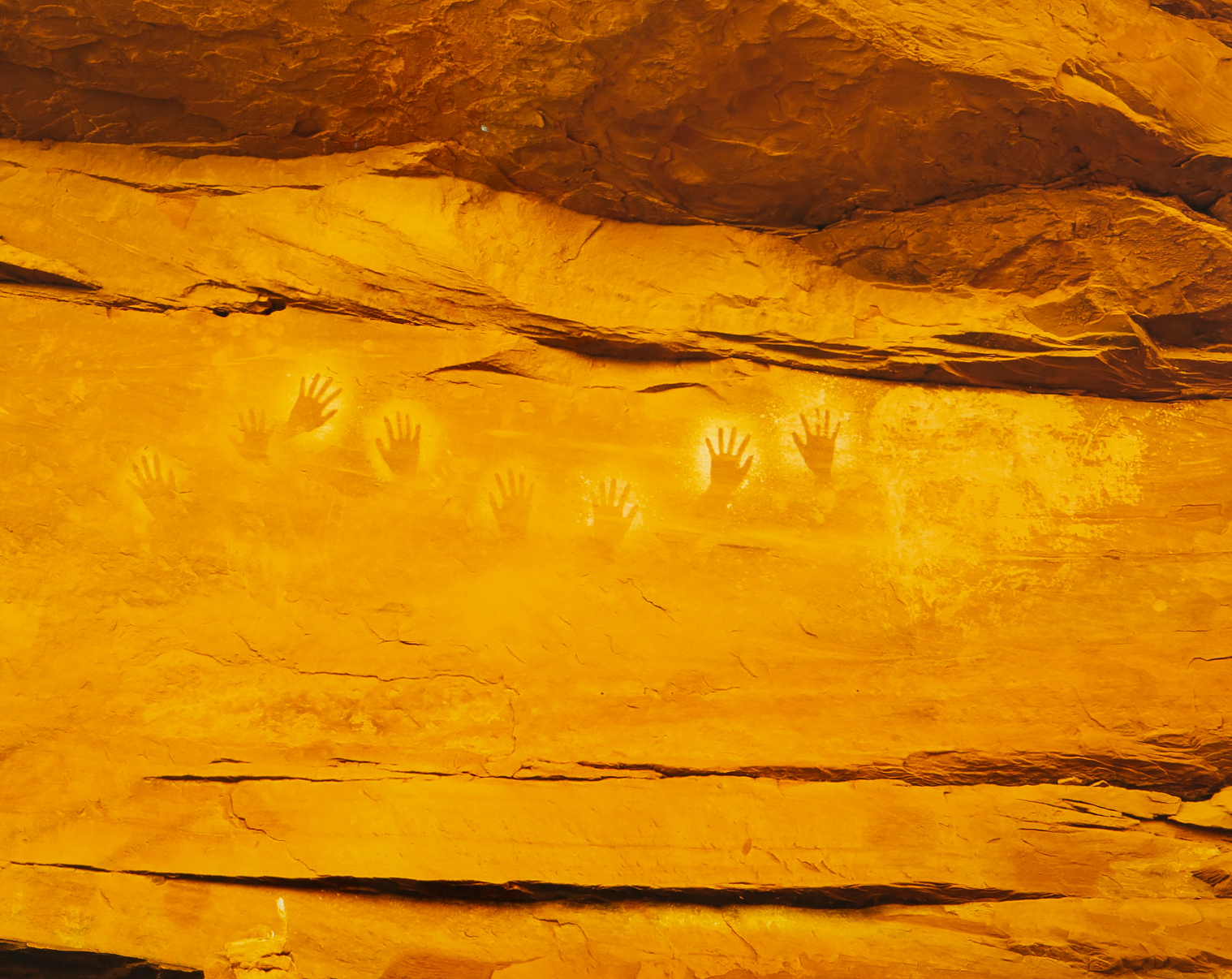Humankind has not woven the web of life. We are but one thread within it. Whatever we do to the web, we do to ourselves. All things are bound together. All things connect.
- Chief Seattle, Duwamish
Physical, spiritual and ecological themes from our natural world, and their implicit interconnectedness, have been rooted in ancient and Indigenous philosophies for centuries. Contemporary ecological beliefs hinge on this idea.
To further illustrate this concept, All Our Relations is an Indigenous prayer of oneness (Mitákuye Oyás’iŋ in the Lakota language), seeking to live in kinship with nature, in harmony with all forms of life: animals, birds, insects, trees and plants, rocks, rivers, mountains and valleys, and human beings. Zoroastrianism, widespread in Iran and Central Asia in the 6th century BC, through caring for the elements and the earth, sees the physical world as a natural matrix of Seven Creations: Fire, Sky, Water, Earth, Animals, Humans and Plants. Purity of nature, in their tradition, is seen as the greatest good. Similarly, other ancient philosophies are concurrent with self-identification of being “at one” with nature and natural phenomena. They lead to ecocentrism and a holistic ecological attitude of “respect for nature.”
Re-Connections: In Kinship With Nature blends artistic expression with environmental activism. The artists address the urgent need to live more responsibly within the Earth’s finite resources. Witness to floods, rising waters and other man-made threats, they imagine a future where we live in harmony with nature and feel an obligation to work together to take action and reverse this trend.
This in-person exhibition will be hosted November 2023 to mid January 2024 at the United Nations Headquarters in New York.
Each place its own mind, its own psyche! Oak, Madrone, Douglas fir, red-tailed hawk, serpentine in the sandstone, a certain scale to the topography, drenching rains in the winters, fog off-shore in the summers, salmon surging up the streams - all these together make up a particular state of mind, a place-specific intelligence shared by all the humans that dwell therein, but also by the coyotes yapping in those valleys, by the bobcats and the ferns and the spiders, by all beings who live and make their way in that zone. Each place its own psyche. Each sky its own blue.
- David Abram, cultural ecologist and philosopher
Oceans Rising
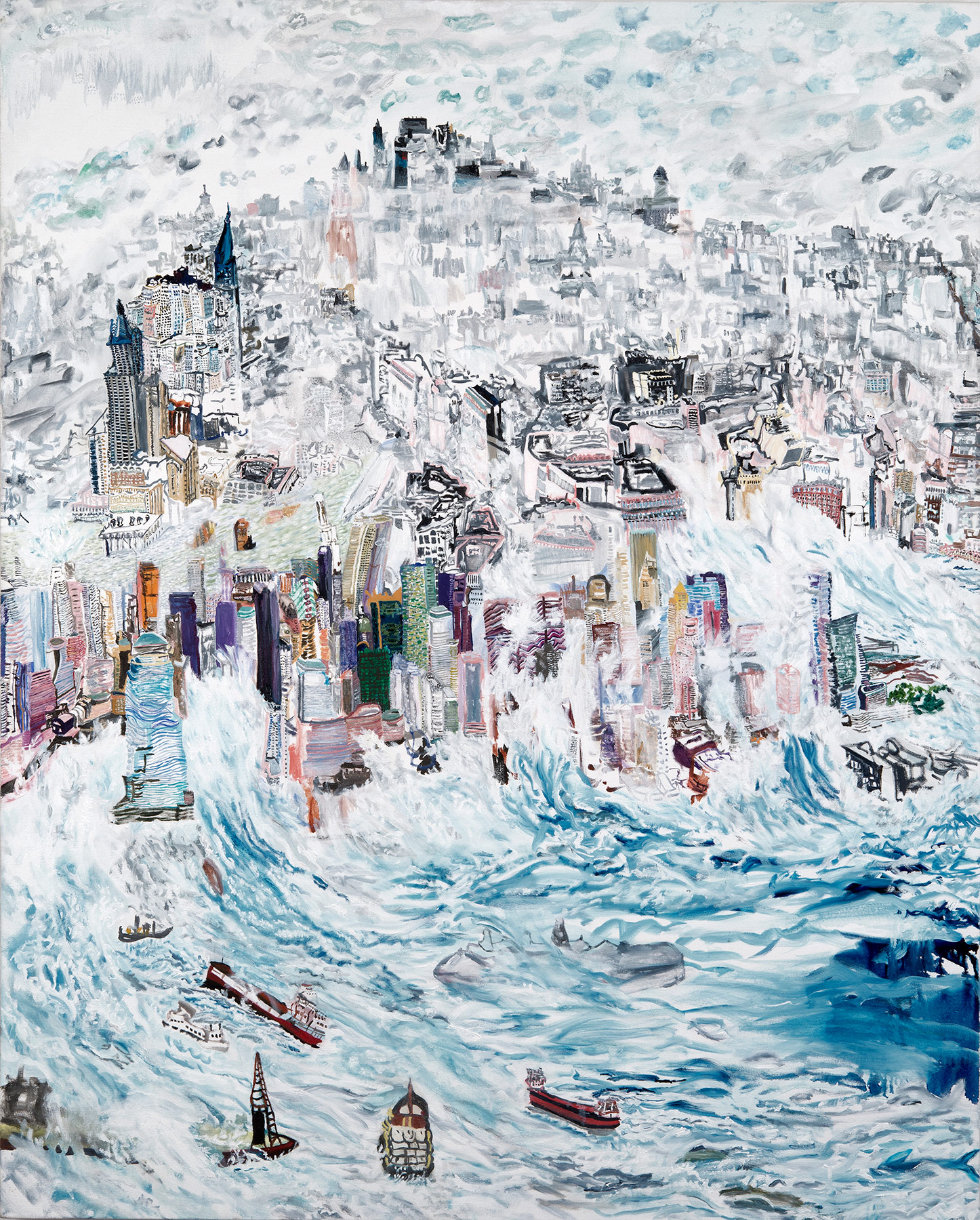
Oil on canvas. 60 × 48 inches (2016/17)
Olive Ayhens is an American artist, Guggenheim Fellow active since the 1970s. Her work is idiosyncratic and often features dream-like landscapes, both urban and nature-based. For thirty years she has contributed to the chorus of environmental alarm by including images of endangered species in her paintings. But now she has portrayed the coming dangers in Oceans Rising.
Presidential Commemorative Smog Plates, 1992
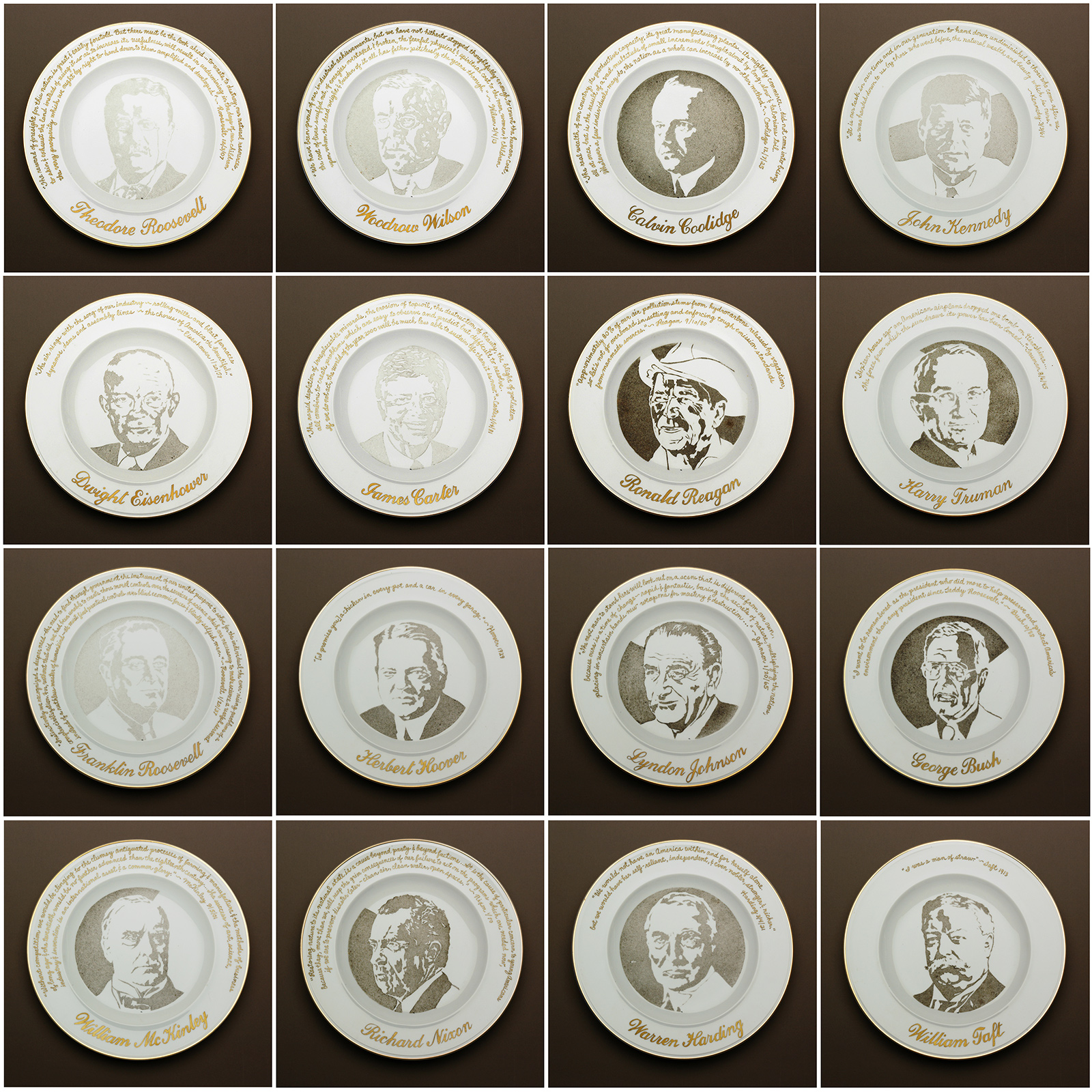
Kim Abeles is an American artist based in Los Angeles whose artworks explore biography, geography, feminism, and the environment. Presidential Commemorative Smog Plates, featured in this exhibition, are made of particulate matter on porcelain. Each has a portrait of a U.S. president with a quote about pollution and industry. They were placed on a rooftop for an amount of time relative to the presidents' environmental records, 4-40 days, longer for the least environmentally conscious presidents, thus showing more accumulation of smog.
Natural Man
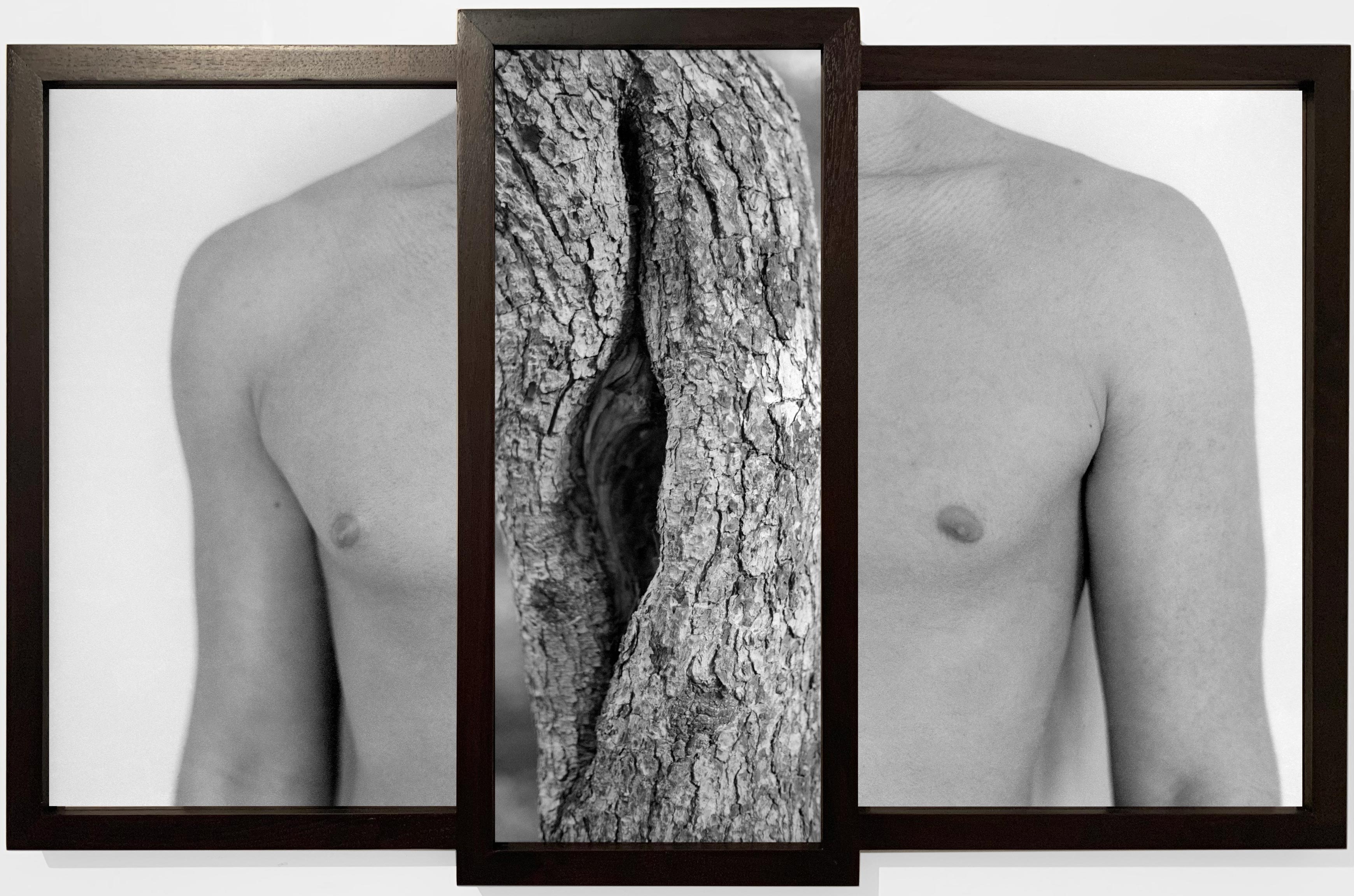
Archival pigment prints and walnut frame structure. 23 4/5 x 36 7/10 inches - Edition 1 of 3 (2021)
Maria Antelman (born Athens, Greece) is a visual artist based in New York. She makes videos, photographs, sound installations and sculptures using both new and traditional technologies. Natural Man is a sculptural photographic work representing a transformative, almost mythological experience. A binary union of biological systems, as opposed to cyborgian bodies, Natural Man is naturally instinctive and exists in the wild. It is in the wilderness, where our instinct lives, where we connect to our animal nature. Technology understands the grammar of our language and the syntax of our thinking but still cannot predict our instinct.
Many Hands Petroglyph
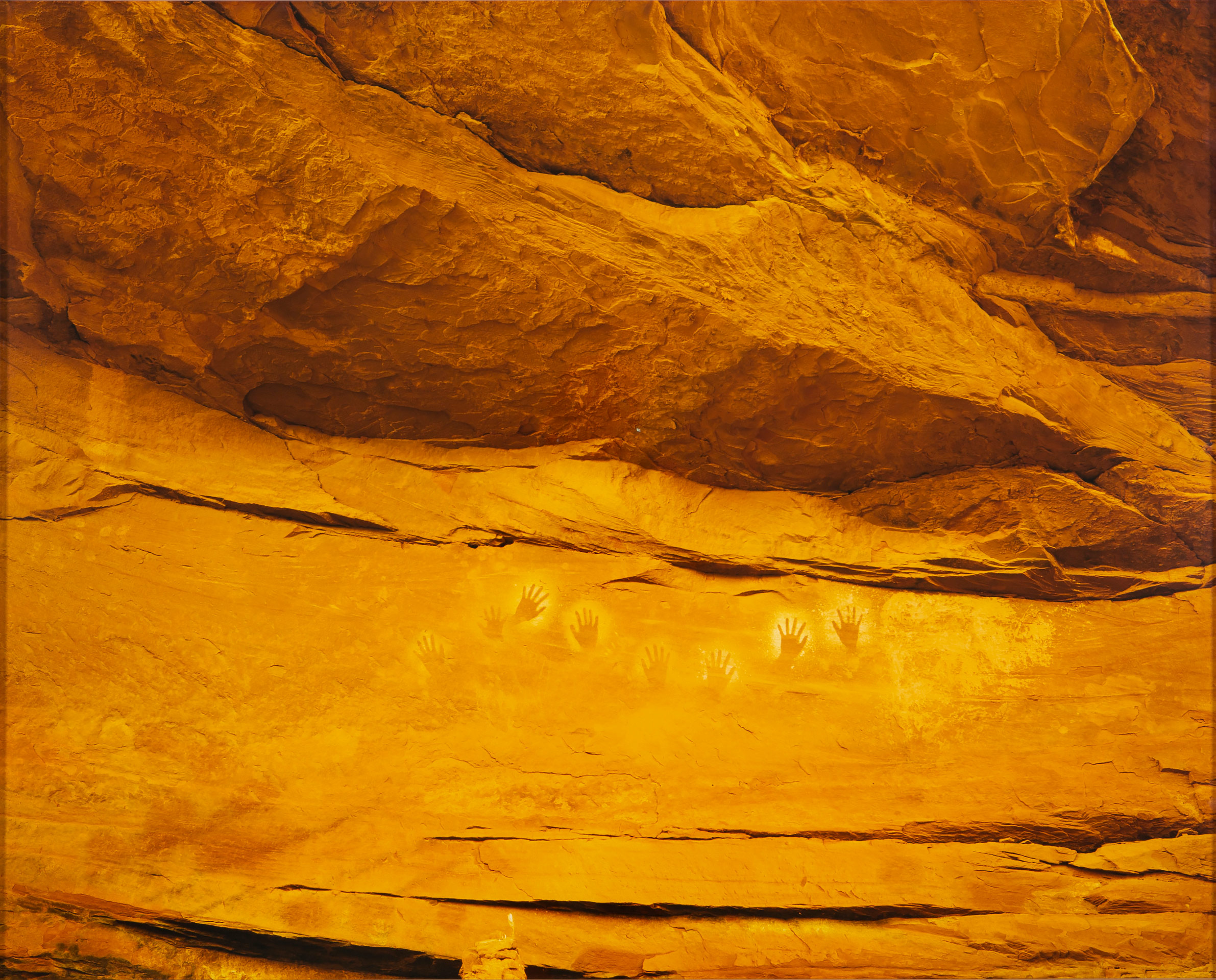
Chromogenic print. Framed dimensions: 40 15/16 x 50 15/16 x 1 7/8 inches (Bears Ears National Monument, Utah, 2018)
David Benjamin Sherry is a New Mexico-based artist who is both challenging and reinvigorating American photography. American Monuments is a photographic series examining our relationship to landscape, climate change, color, queer identity, and historical photography, using monochrome depictions of the American national monuments being targeted by the Trump administration for immediate development in the interest of oil, coal and uranium exploration.
Lewis Lake WY 3
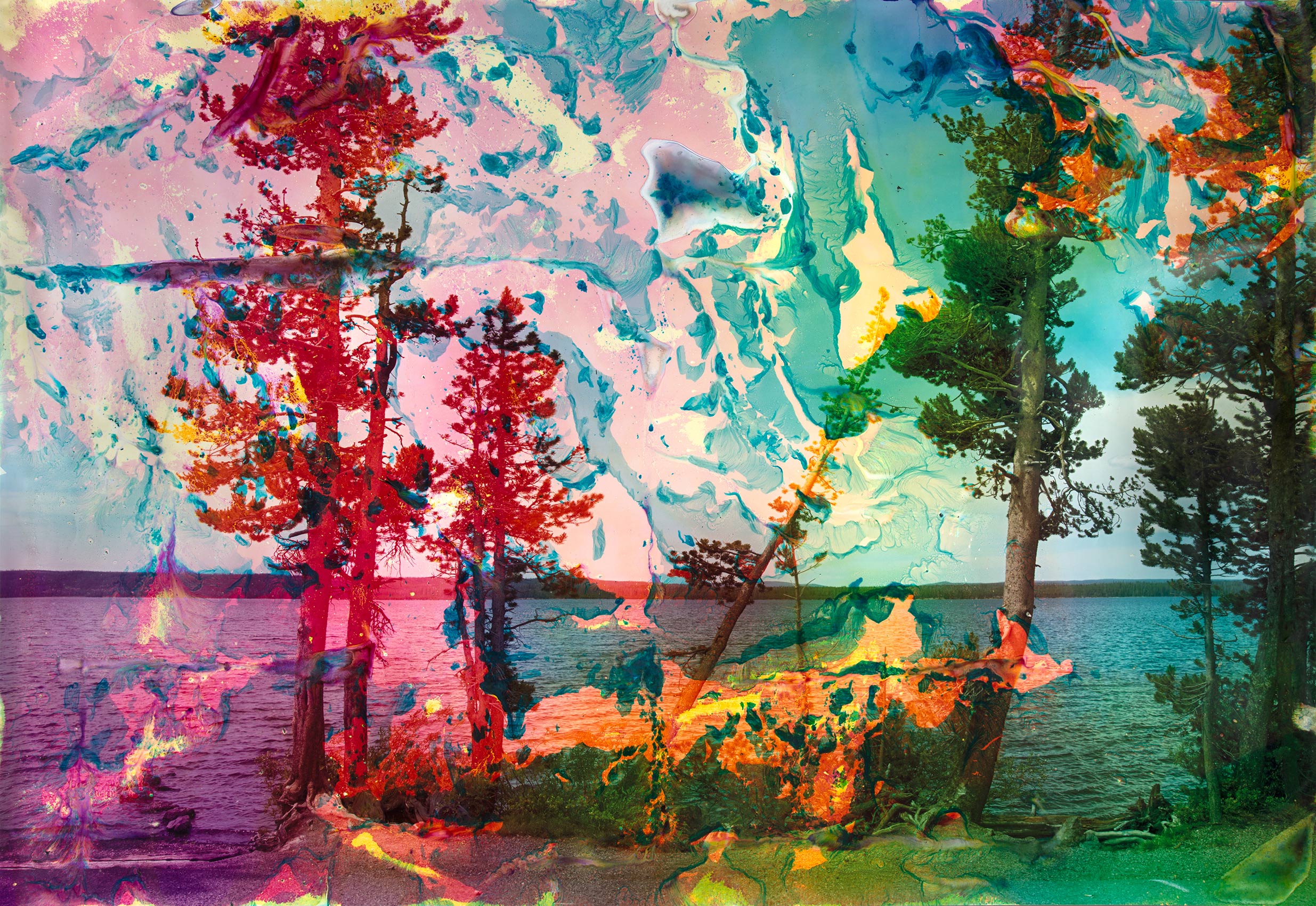
Chromogenic print soaked in Lewis Lake water. 72 x 105 inches (2013)
“Lakes and Reservoirs,” is a series of photographs by Los Angeles-based photographer Matthew Brandt.
Using his surroundings as an additive medium, Brandt’s printed photographs are bathed in a mixture of water collected from the site in which the composition was derived. Through this experimental process, the artist becomes closer to his specific subjects and gains a better understanding of his surroundings as a whole. This controlled technique mirrors the chemical composite of the photographed landscape and therefore symbolizes today’s ecological concerns about the deterioration of our natural world.
Bridges Over Flint

24 silver gelatin prints developed with Flint, Michigan tap water, vitamin C, bleach, and wine. 24,8 x 10 inches each (2016)
In his “Bridges Over Flint” series, Brandt developed the negatives using a solution of Flint, Michigan, tap water and vitamin C, turning the resulting gelatin silver prints into physical evidence of the dangers Flint residents faced when, in 2014, the city switched from supplying treated water to Flint River water and contaminants caused lead from the town’s pipes to leach into the water supply. The work is a reminder of the dangers, invisible to the naked eye, faced by the people of Flint during the water crisis.
Oil Bunkering # 9
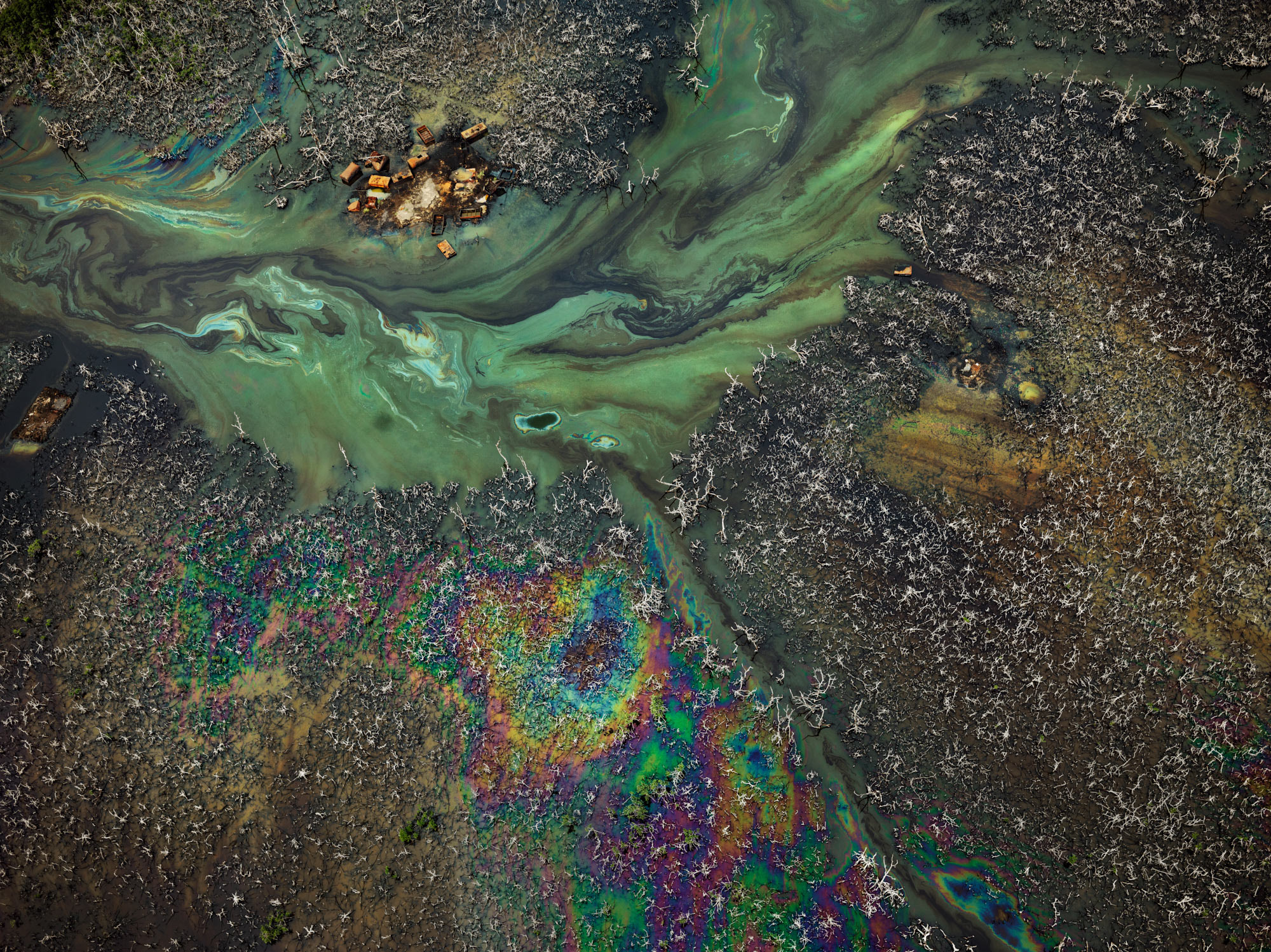
Chromogenic color print. 48 × 64 inches (Niger Delta, Nigeria, Africa, 2016)
Edward Burtynsky is a Canadian photographer whose works depict locations from around the world that represent the increasing development of industrialization and its impacts on nature and the human existence.
Since the discovery of oil in 1956, when Nigeria was still a British protectorate, the resource has proven both a blessing and a curse. For decades, multinationals have abdicated responsibility for devastating oil spills onto land and water. Despite gaining independence in October of 1960, much of Nigeria’s oil wealth continues to be diverted outside the country. As a result, poor communities have begun pirating crude oil from pipelines—often with the support of benefitting local elites and politicians—through a process known as ‘bunkering’.
I wish my artwork could persuade millions of people to join a global conversation about sustainability. - Edward Burtynsky
Soup: 500+
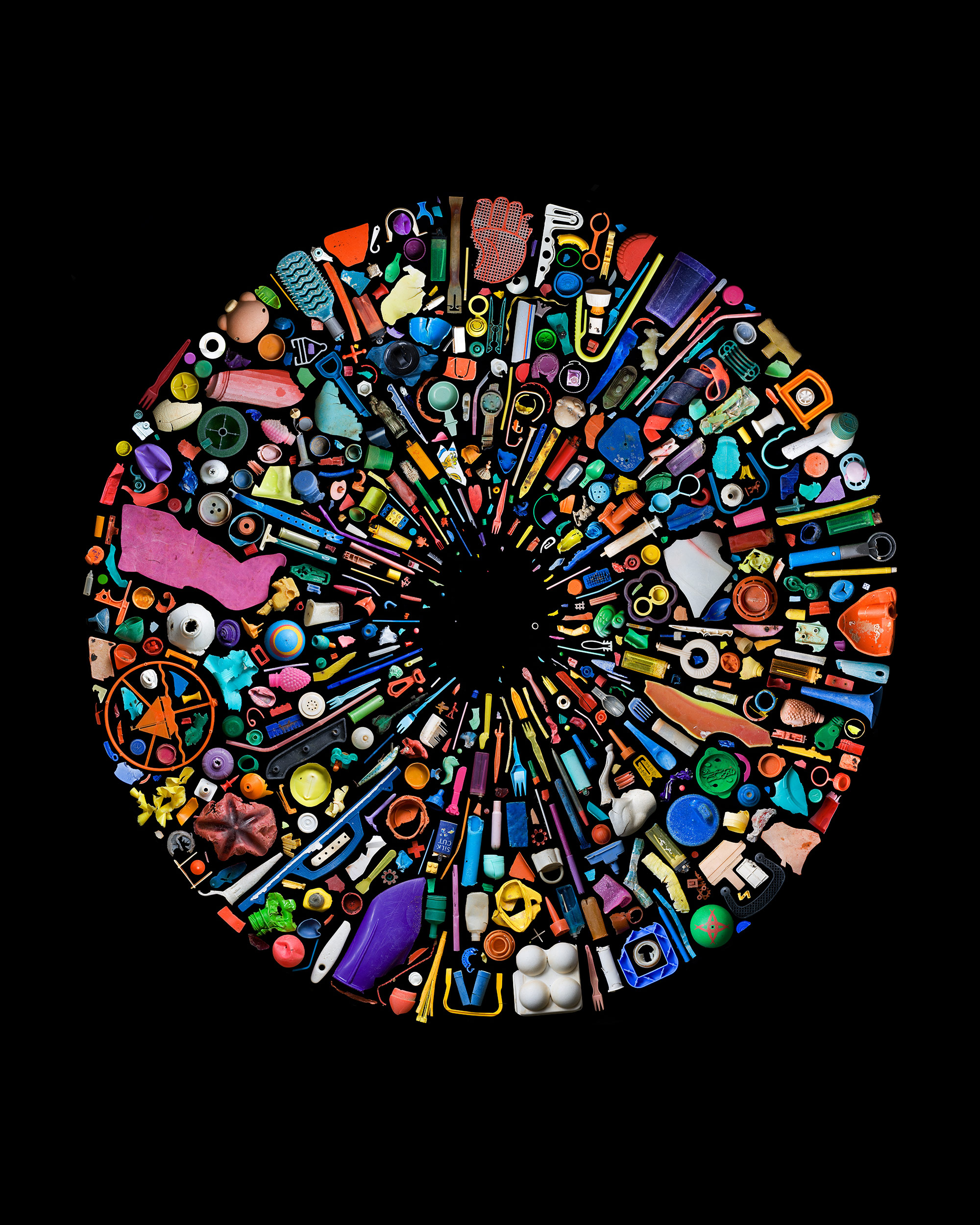
(Ingredients: representing more than 500 pieces of marine plastic debris found in the stomach of an Albatross chick). 100 x 73 cm. Edition 2/12 +2 AP
Mandy Barker is a British photographer whose work involving marine plastic debris has received global recognition for more than 12 years. Working with scientists she aims to raise awareness about plastic pollution in the world's oceans, highlighting the harmful effects on marine life and ourselves - ultimately leading the viewer to take action.
By bringing attention to marine plastic pollution, it is hoped my work will help inform, and raise awareness about this issue of climate change. - Mandy Barker
Antworks
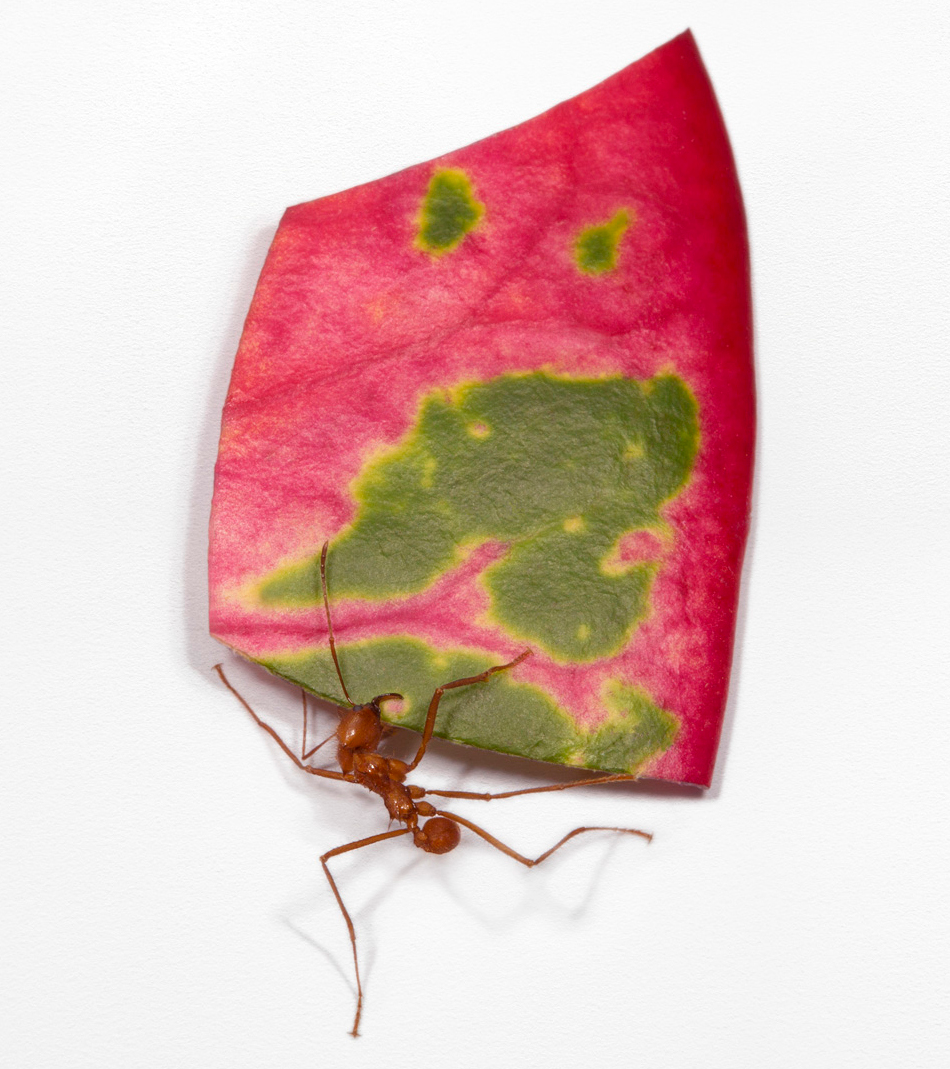
Pigment print. 30 x 30 inches (2020)
Catherine Chalmers is an American artist and photographer. The multimedia “Leafcutters” project is an unusual collaboration with millions of wild ants. Since 2008, Catherine has been filming, photographing and following the fates of more than a dozen colonies of leafcutter ants on the Osa Peninsula in Costa Rica.
Leafcutter ant colonies have eerie parallels to human society, and this is the conceptual basis and the inspiration for the work. To quote from eminent biologist E.O. Wilson, these ants are “the most complex social creatures other than humans.” They are the charismatic mini-fauna, the Einsteins of the insect world, and the masters of chemical communication.
The project focuses on four supposedly unique human traits – language, ritual, war and art – and the narrative themes aim to blur the boundaries between culture and nature.
Hverarönd #3
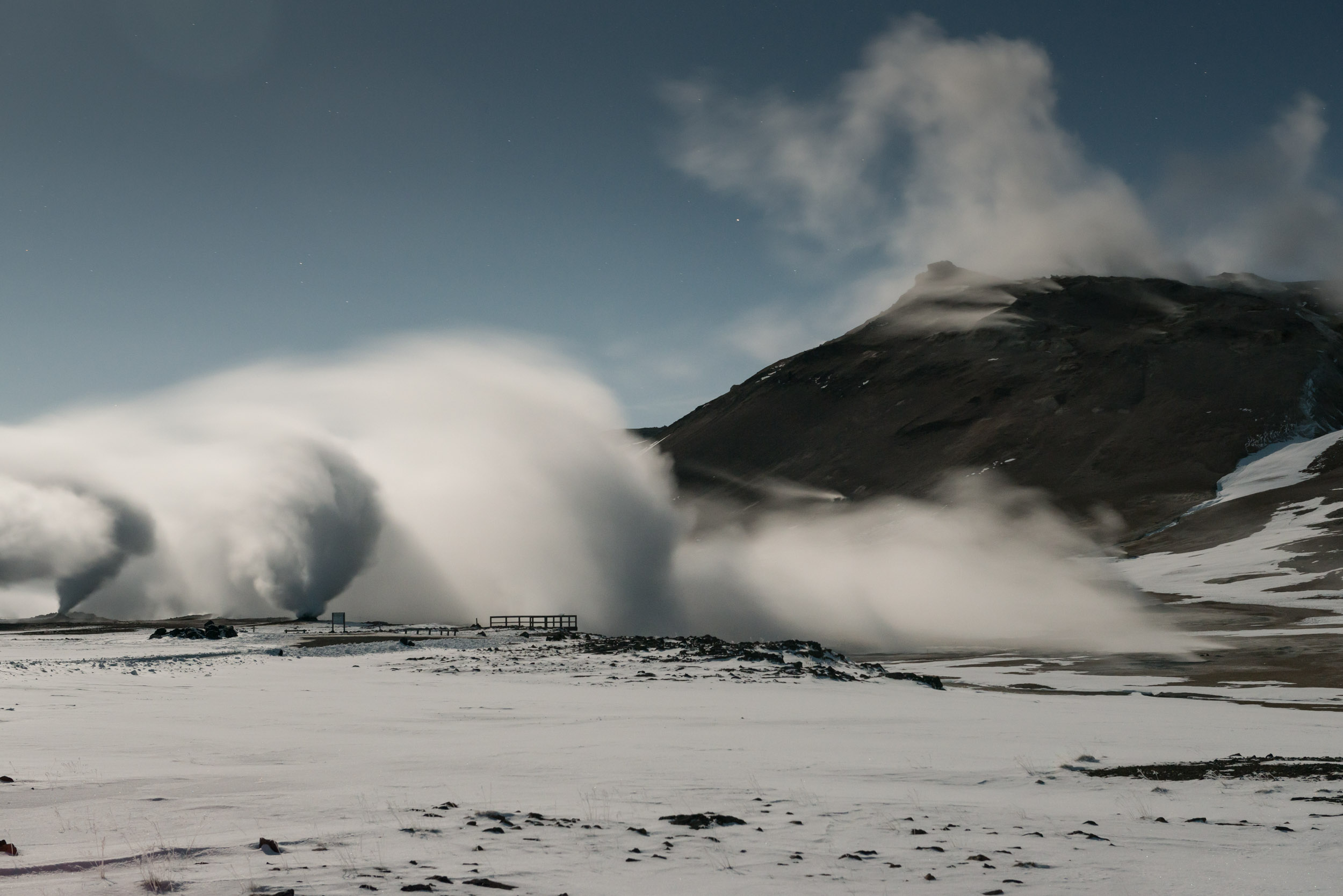
Archival pigment print. 20 x 30 inches (Iceland, 2013)
Kris Graves is an American photographer who primarily works in portraiture and landscape photography.
Iceland is isolated, remote, and independent. Alone in a cold sea, sparsely populated, its volcanic visage is harsh and unrelenting. Its relationships with its neighboring countries reflect the residents' independence and stoicism, maintaining distance and self-sufficiency. Discovering Iceland by itself, finding what's missing from its own story, and seeing the country through its one (mostly) drivable road is its true discovery: volcanic and ever-changing landscapes, barren fields, inhospitable winters, sparse population.
Paul First Nation: 2005 Wabamum Clean Up Site of a 700,000 Litre Oil Spill
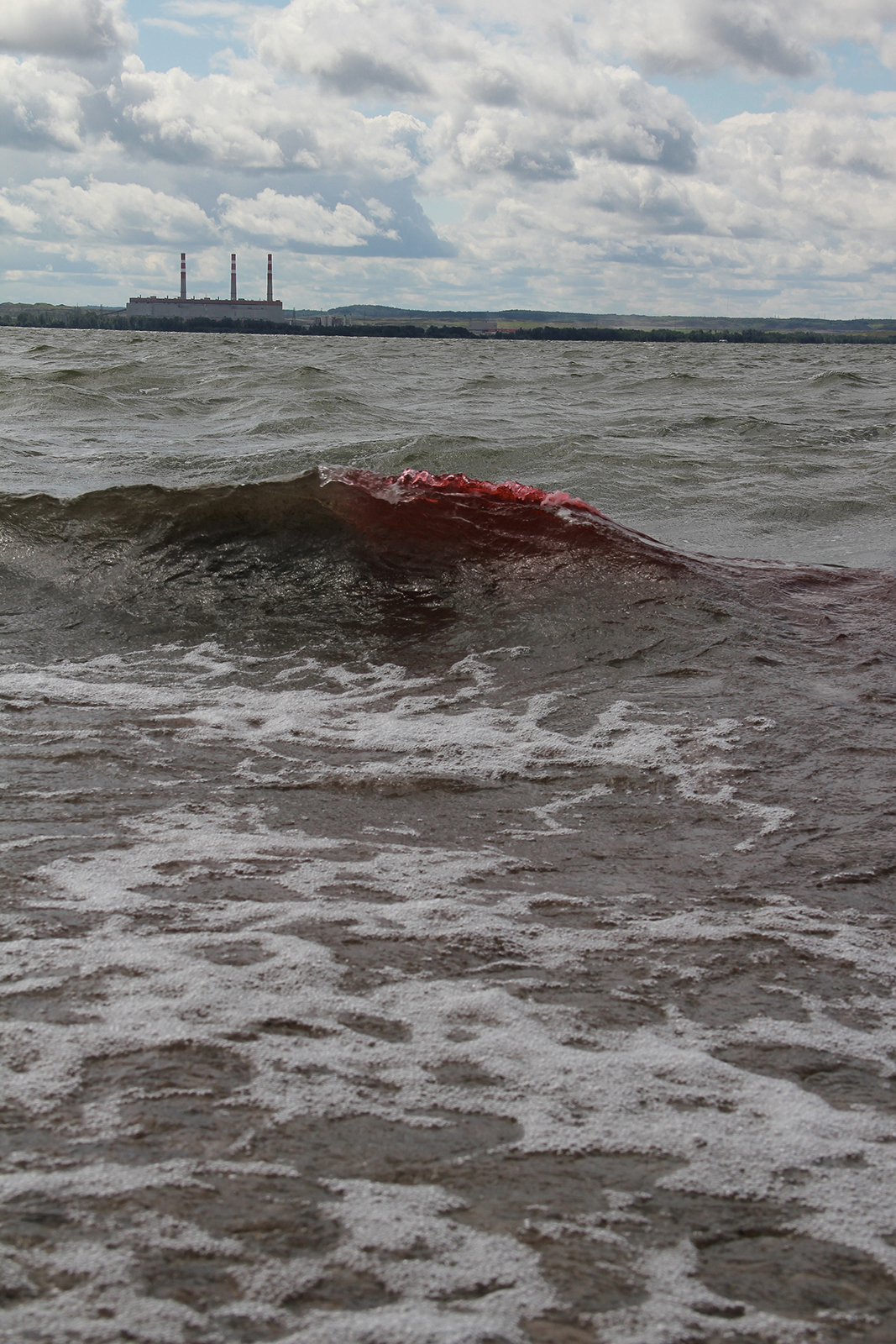
Digital print on rag paper, 32 X 23 inches. Collection of the artist (2011)
Tanya Harnett is a member of the Carry-The-Kettle First Nations in Saskatchewan. She is an artist and a professor at the University of Alberta. For two weeks during the summer of 2011, Tanya Harnett travelled to four reserves in the Treaty 6 territory of northern and north-central Alberta, and to the un-ceded traditional lands of the Lubicon Lake Nation, where there are problems with the water. The most highly publicized damage was caused by the CN train derailment, in 2005, that spilled 1.3 million litres of bunker oil and hazardous chemicals into Lake Wabamun on the Paul Band reserve. Harnett knew of other damaged water from news stories or by word of mouth. In addition to Lake Wabamun, she drove to Cold Lake, the Driftpile River, Lubicon Lake, and Lac Ste. Anne.
Driftpile First Nation: Driftpile River from Swan Hills
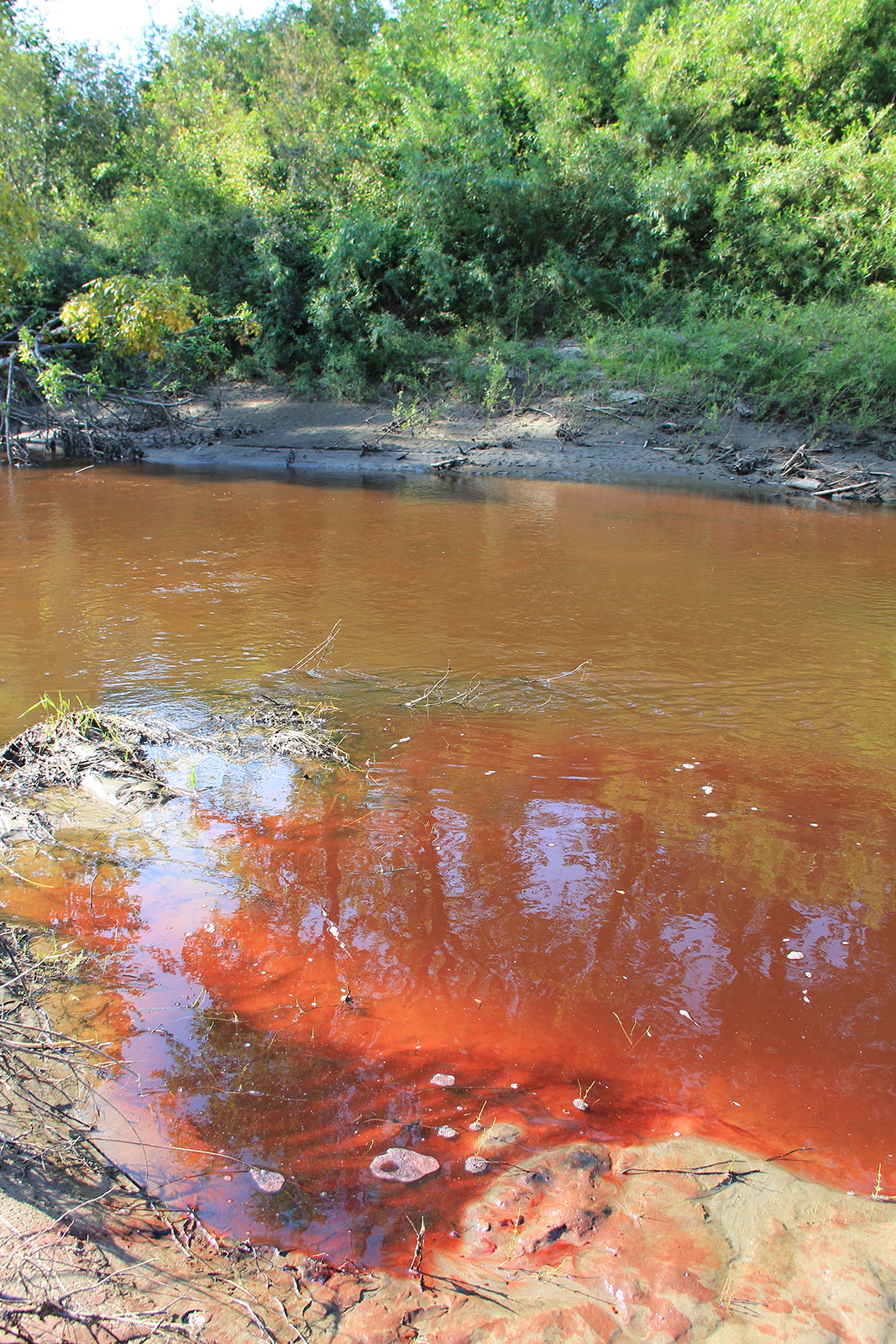
Digital print on rag paper, 32 X 23 inches. Collection of the artist (2011)
The size of the damaged sites varied, from lakes to a river and a spring, but the water and the people — Cree, Chipewyan, Nakota Sioux, and Nakoda — who live on these reserves had suffered, and still were suffering, significant distress. She went there to photograph these waters because the damage done to them is largely unknown beyond First Nations communities. To bear witness and to give testimony was Harnett’s way of framing the question that formed the impetus behind the artwork she was undertaking: what is the Indigenous perspective on landscape?
Excerpt from the poetics & politics of scarred/sacred water Ellis, J. (Ed.). (2018). Water Rites: Reimagining Water in the West. Calgary, AB: University of Calgary Press.
Season's End
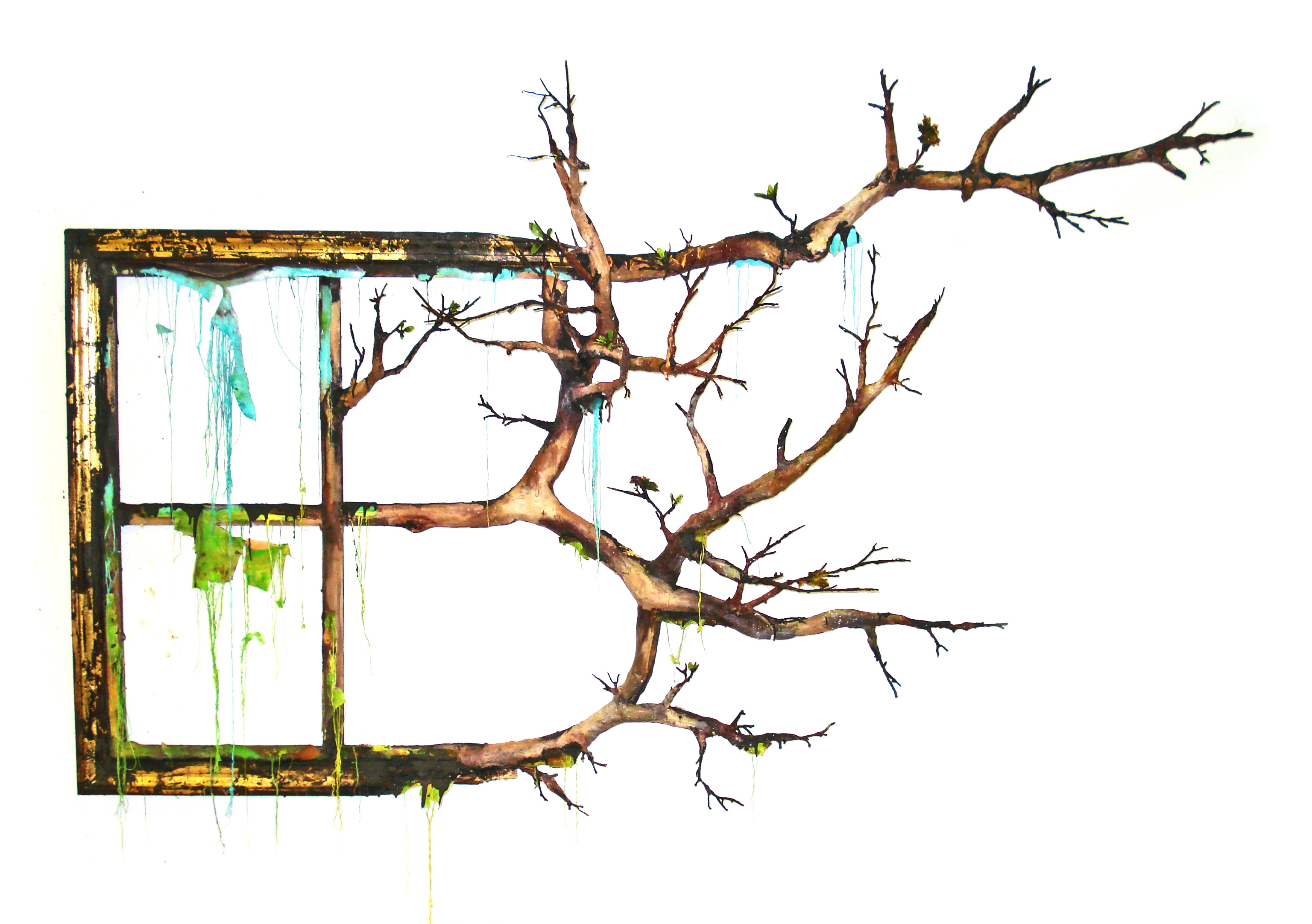
Painting stretcher, wire, foil, paper, glue, canvas, thread, wood molding, gold leaf, plastic. 51 x 80 x 20 inches (2011)
Valerie Hegarty is a Brooklyn-based artist who makes paintings, sculptures and installations that explore issues of memory, place and history. Hegarty’s work is characterized by canvases and antiques that have been burned, ripped, cracked, shot at or otherwise destroyed. However, the devastating state of Hegarty’s work is intentional. Her work is intended to evoke man’s struggle to civilize nature and the consequences which emerge.
Outdoor Drawing
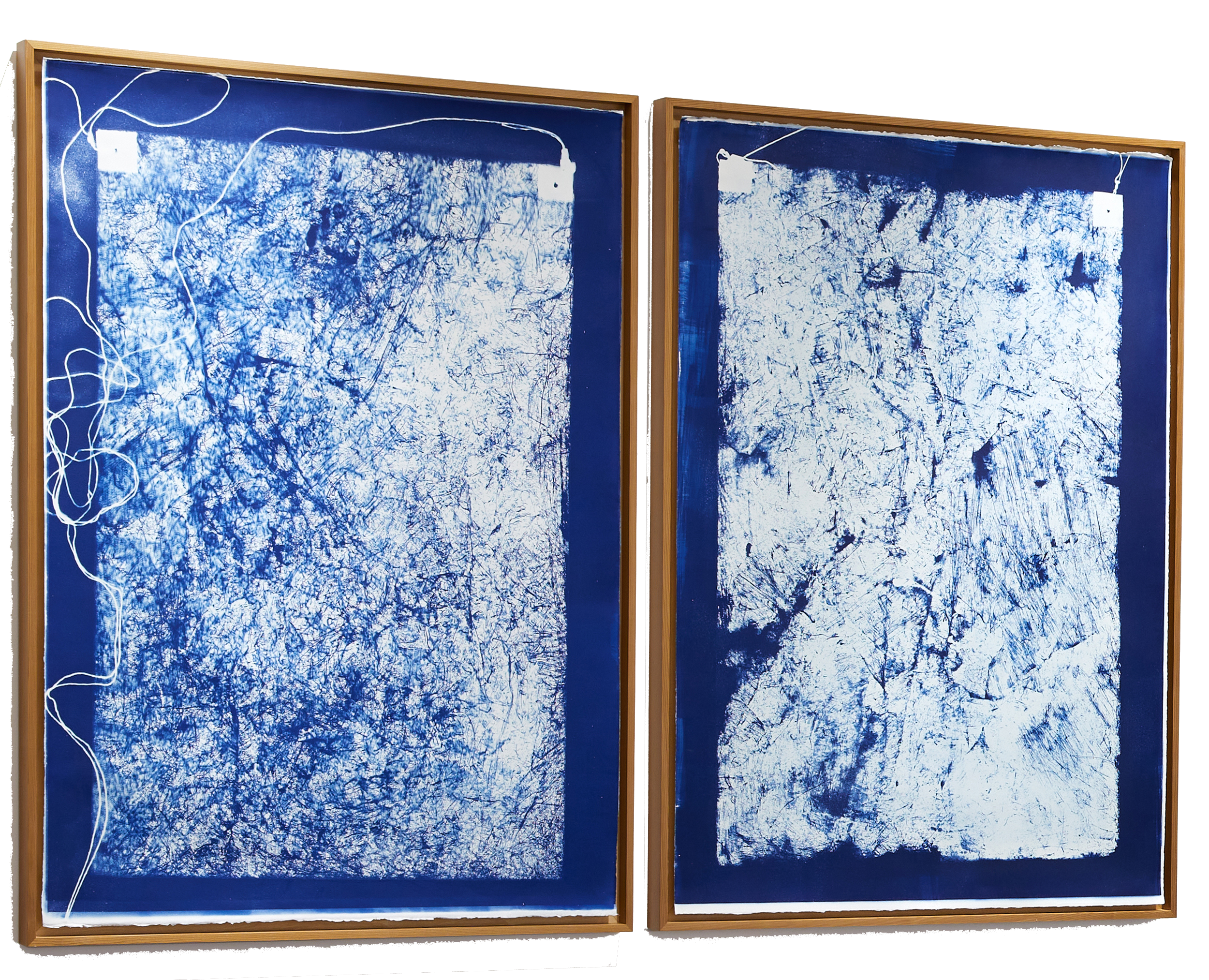
Hand-coated Cyanotype print on Platine paper. Each print: 40 x 30 inches, walnut frame (Governors Island: East & West, 2021)
Betsy Kenyon lives and works in New York City. She has explored novel printing techniques in her works over the past decade, both in the darkroom and with the natural elements. In her recent Outdoor Drawing series she coats large sheets of mylar with Sumi ink, a non-toxic ink made of soot and fish glue. She casts these hand-coated cliché verre “negatives” into bodies of water imaging the cardinal directions of a particular land mass. Natural movements of water, earth and air transform the coated mylar uniquely, then sunlight is used to transfer these marks onto the finished print through outdoor exposures. The waters surroundings these locations is used again during the development process, further integrating geography and nature into the finished works. Included in this exhibition are two cliché verre images made at the eastern and westernmost points of Governors Island, New York City. These images record connection; place and time, chance and pattern, a pictorial evocation of sunlight and chemistry drawn into the work directly by the elements.
Sizibeni
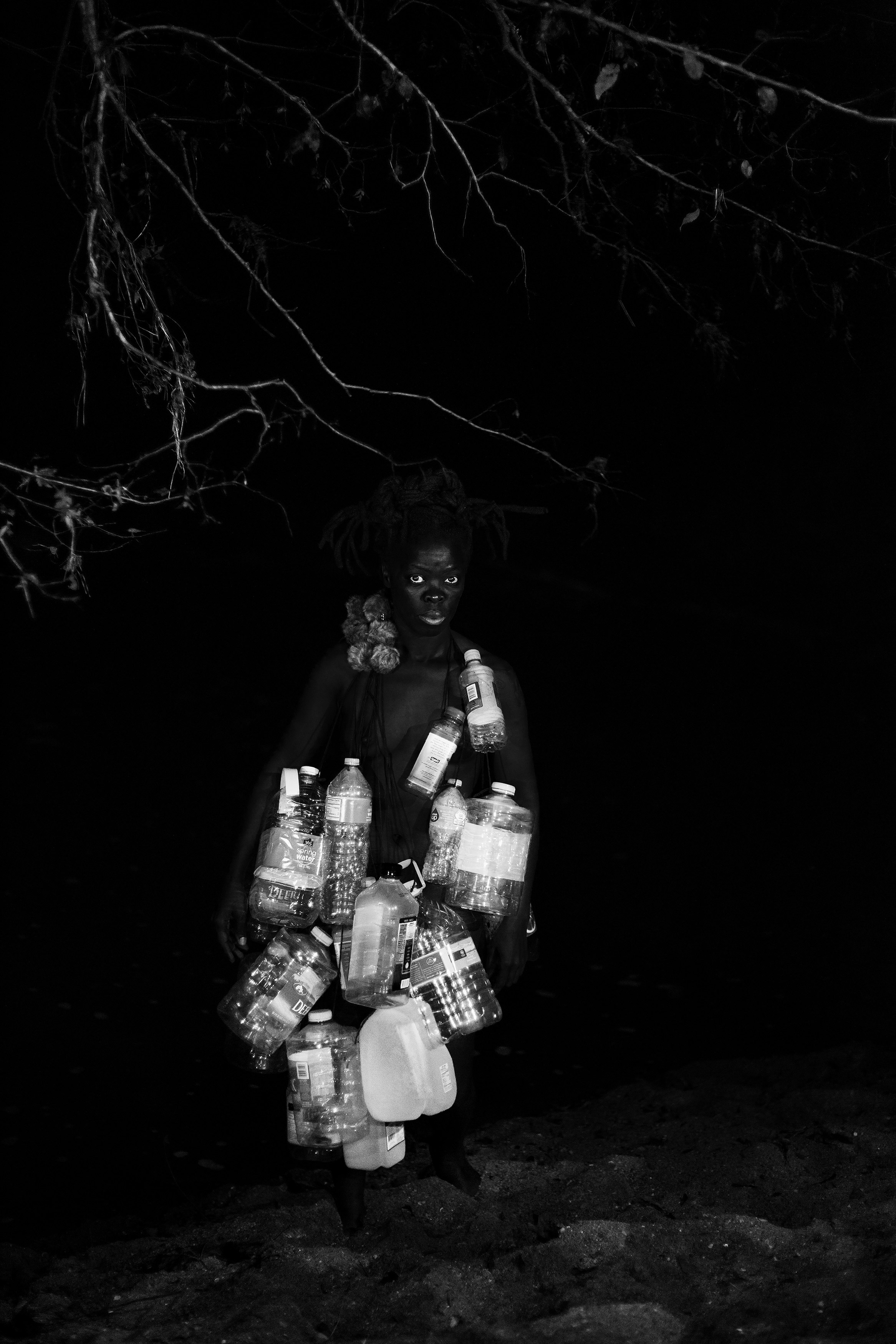
Gelatin silver print. Courtesy of the artist, Yancey Richardson, New York, and Stevenson Cape Town/Johannesburg (West Point, North Carolina, 2017)
Zanele Muholi is a South African artist and visual activist working in photography, video, and installation. Taken in cities across Europe, North America, Asia, and Africa. Muholii’s socially engaged, radical brand of self-portraiture transforms found objects and quotidian materials into dramatic and historically loaded props, merging the political with the personal, and aesthetics with history. Rubber tires, cable ties, or electrical cords invoke forms of social brutality and exploitation; sheets of plastic and polythene draw attention to environmental issues and global waste, while accessories like cowrie shells and beaded fly whisks highlight Western fascinations with clichéd, exoticized representations of African cultures.
Euclidean Gris Gris (The Young Shall Inherit the Earth)
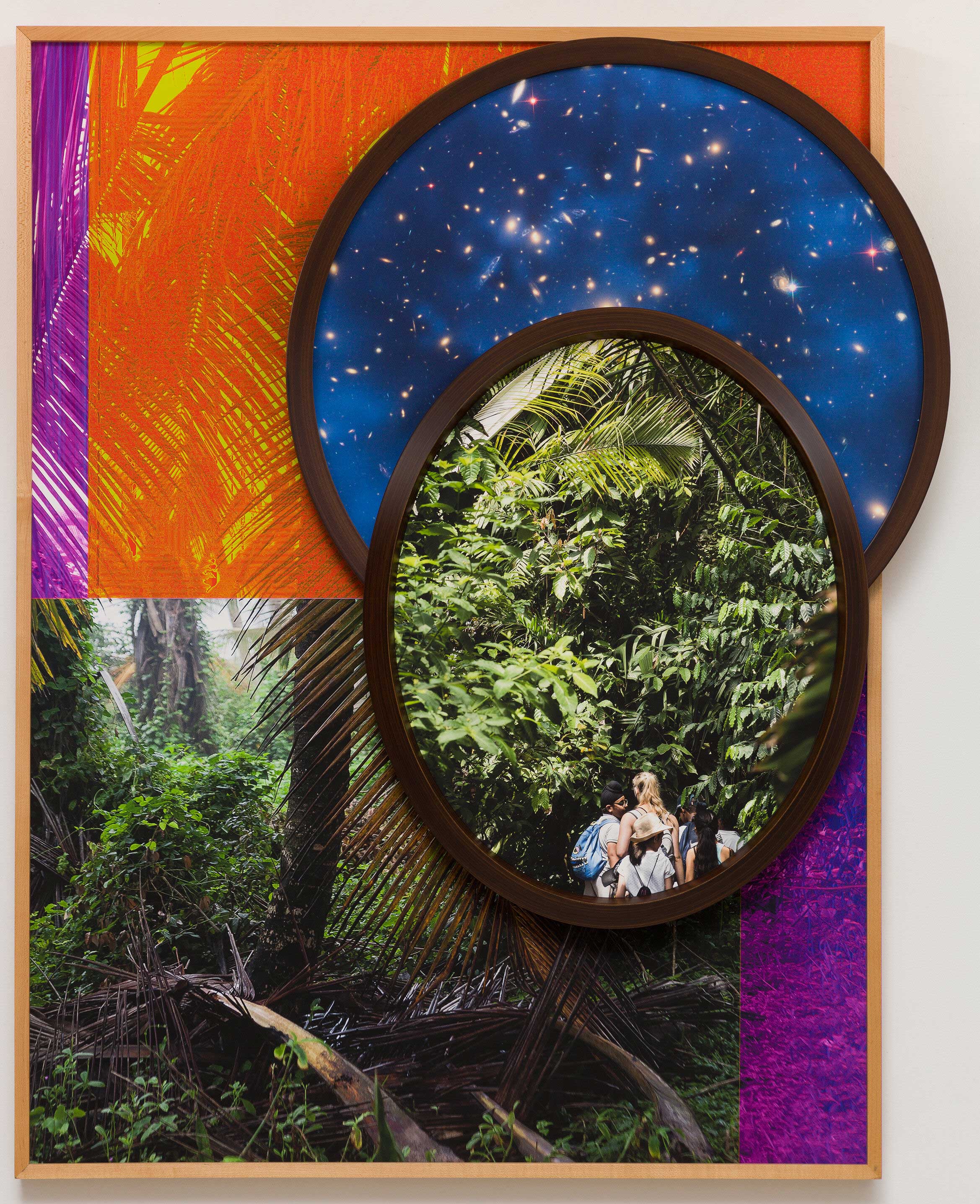
Three archival pigment prints in artist's frames, 30 3/4 x 30 5/8 x 3 1/4 inches (2019)
Los Angeles-based artist Todd Gray is known for photography, performance, and sculptural works that explore contemporary and historical examinations of power in relationship to the African Diaspora. His latest work consists primarily of photographs from his own archive juxtaposed with one another, then mounted within found frames as a structuring device. In recent installations he pairs photographs of rural scenes in Ghana (where Gray maintains a studio) with formal imperial gardens in Europe. In his work Gray explores the historical constructs of the “logical” and geometrical gardens of Europe—an aesthetic manifestation of the idea of disembodied reason—with the “sublime” nature found in African landscapes. In the title of the artwork, Euclidean Gris Gris (The Young Shall Inherit the Earth) (2019), Gray combines contrasting language to frame the work within a broader cultural critique. Gray’s project pushes beyond these binaries, referencing the Euclidean—Western influences—and Gris Gris—African animism and poetics.
Geopolitics of Soil
Christopher Lin is a Brooklyn-based artist and educator with a background in research science. Fueled by a lifelong obsession with fossils, his experimental installations, sculptures, and performances question the world we inhabit and envision the one we will leave behind. Often collaborating with non-human organisms and wider ecologies, his time-based works synthesize elements of environmental ecology with Zen poetics to explore the interconnected nature of our material world.
Geopolitics of Soil is a durational work which addresses the subject of borders and nations from the perspective of the living earth. A world map replete with discrete colors marking distinct nations and their geopolitical nomenclature is set within a culture of bioactive soil. Over the duration of the work, detritivores, such as earthworms, isopods, and springtails, as well as fungi feed on the map dissolving a diagram defined by borders, names, and separated polygonal structures into a body of homogenous living earth. As the map slowly disintegrates, seeds from composted material germinate and burst through the surface while various plants propagate and reanimate due to the rich soil created by the decay. This project began streaming as a live feed for Re-Connections: In Kinship with Nature, hosted at the United Nations for Earth Day 2022 and ended on Earth Day 2023. The footage was then compressed into a timelapse animating this slow evolution into a dynamic visualization of decay and rebirth.
Voyage of Acceptance
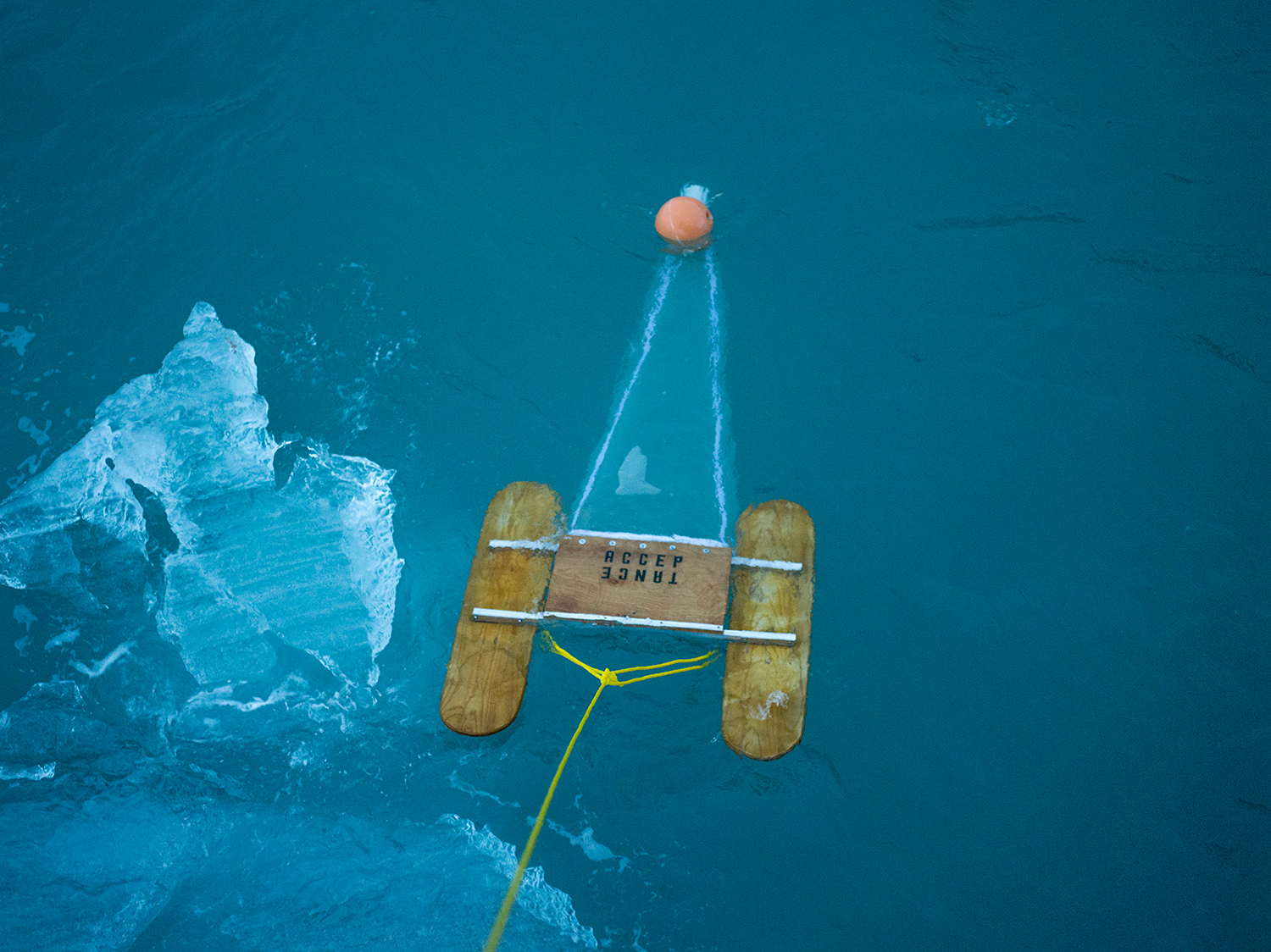
Single Channel HD video with sound. Running time 9:48min.
Oskar Landi is an Italian photographer and filmmaker. Landi’s lens-based work examines our relationship with nature and the environmental challenges of our time. His ongoing project at the root of his works in this exhibition has evolved into a collaboration with NASA on a remote sensing study of microplastic pollution. The “Voyage of Acceptance” chronicles the journey of a net-tow apparatus he fabricated and deployed in the Arctic archipelago of Svalbard to collect floating microplastics. The plastic particles it collected were finally photographed pinned on needles 1mm in diameter. The ‘hot needle’ technique can be employed to discern synthetic materials that react to heat from their organic counterpart, before microscopic analysis. Closely related to climate change and undeniably manmade, plastic pollution has penetrated permanently every ecosystem on earth. Video
Hot Needle #1 (Blue)
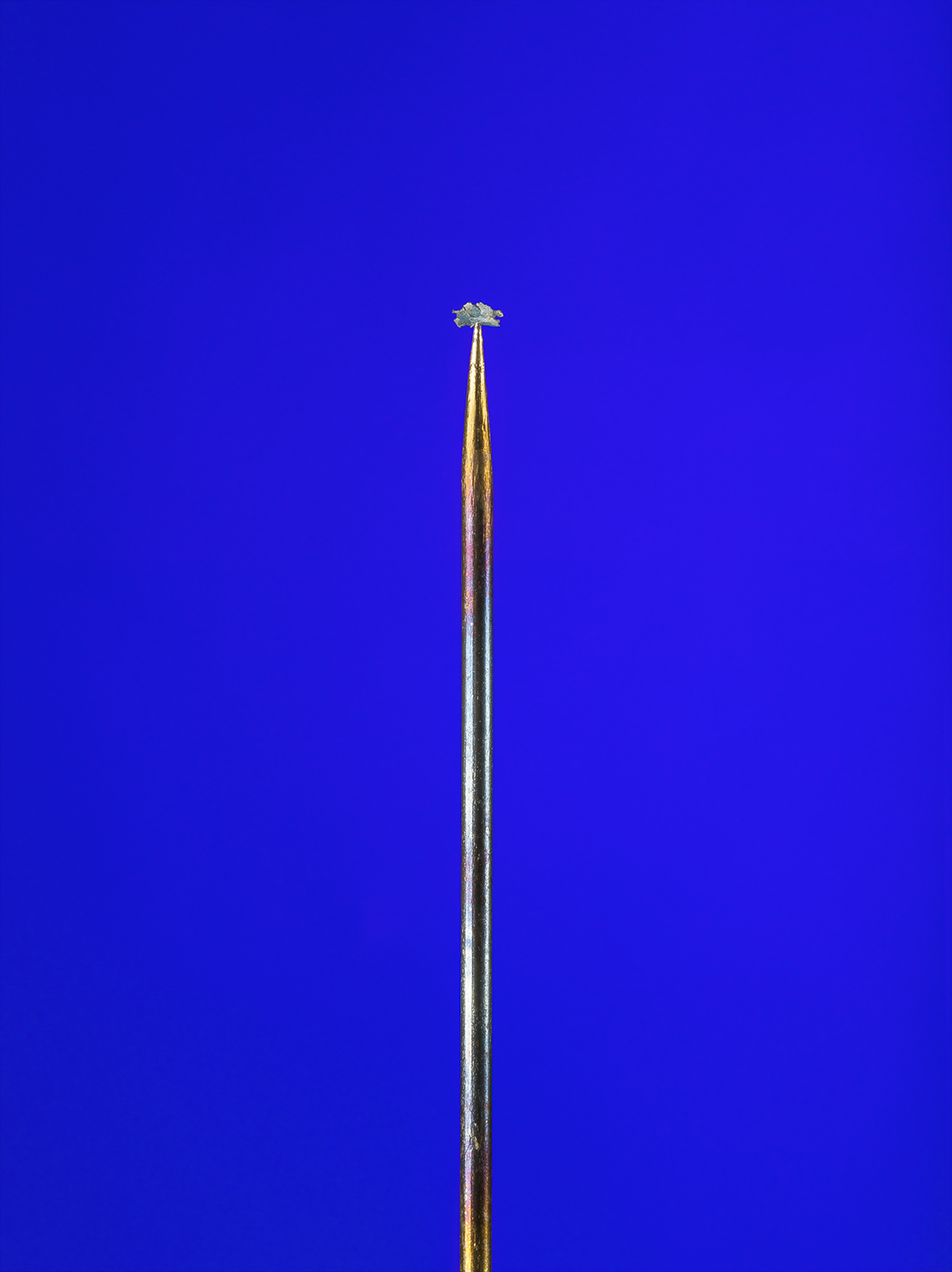
A polyethylene particle approx. 1.6mm pinned on heat colored needle.
For a Week Without Speaking
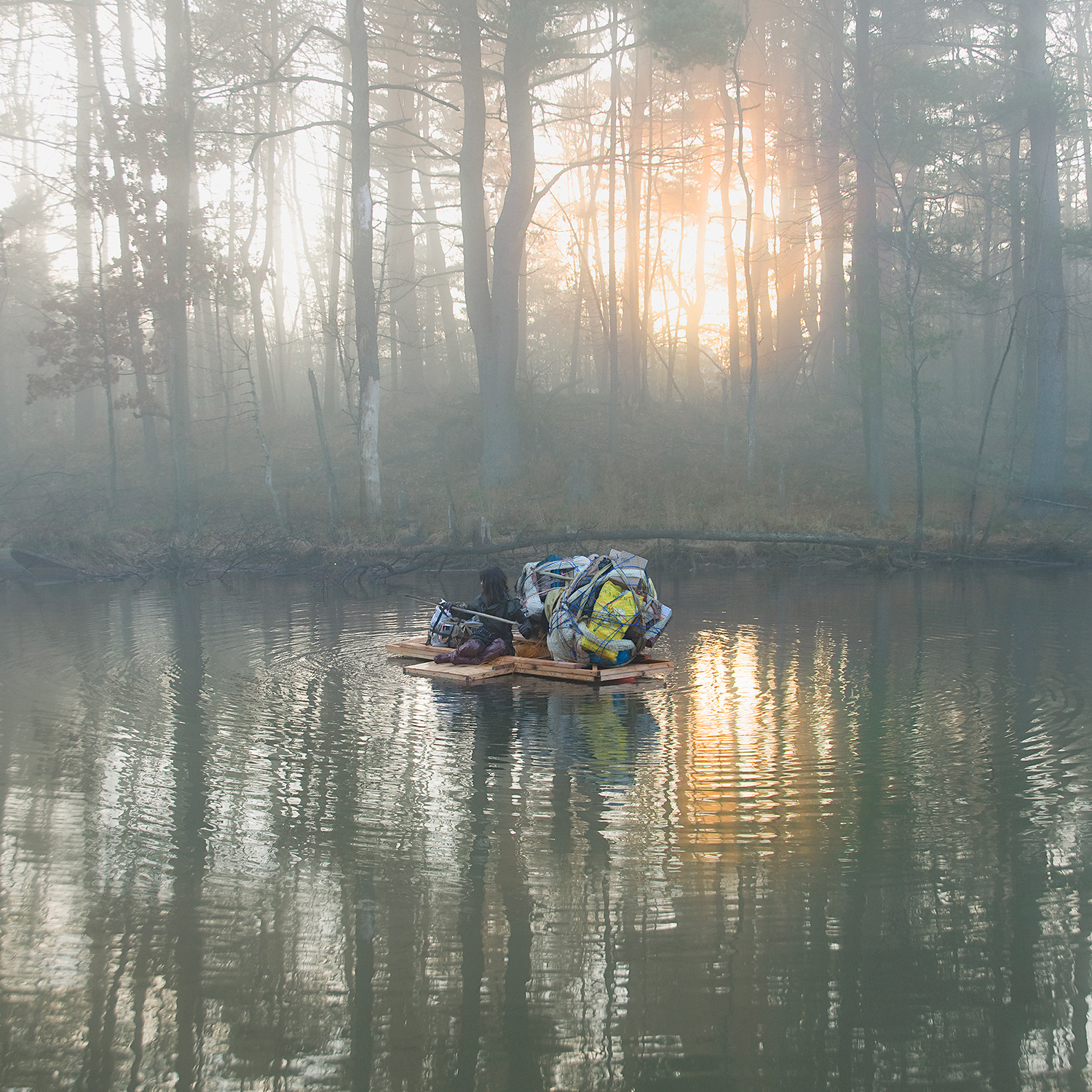
Chromogenic dye coupler print. 40 × 40 inches (2012)
Mary Mattingly is an American visual artist living and working in New York City. Through photography, sculpture, installation, and performance, Mary Mattingly imagines a dire post-apocalyptic future. In Mattingly’s imagination, humans are forced to live nomadically, scavenging the wreckage of civilization and living by their wits. She imagines (and sometimes develops) unique transportation solutions for her subjects, such as the Personal Flight Machine (2007) and Kart (2008), a shelter built on a bike. In 2008, she also created the Waterpod, an alternative living model that consisted of a movable, floating barge that could adapt to changing sea levels.
Submerged Forest, Rondônia, 2020
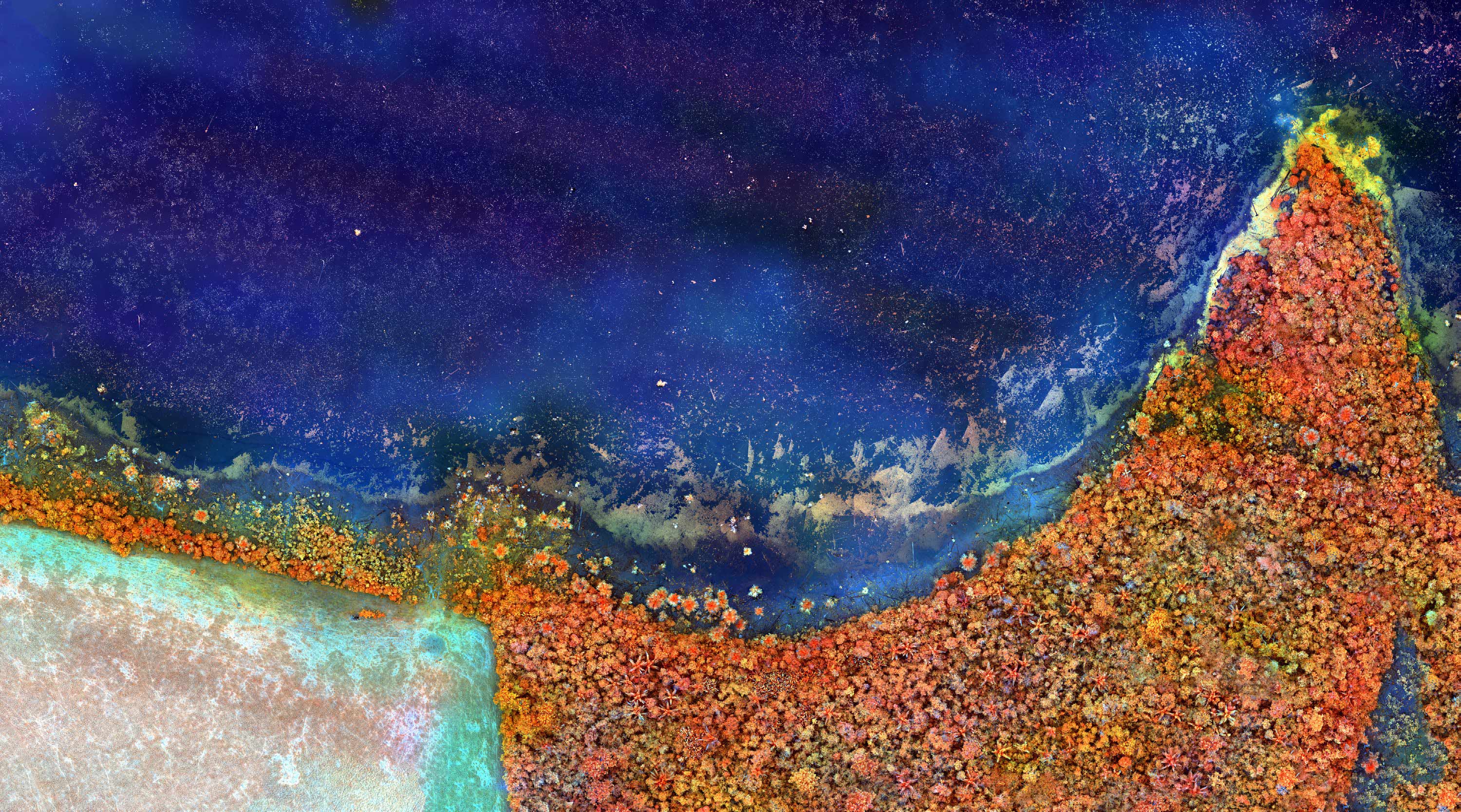
Courtesy of the artist and Jack Shainman Gallery, New York.
Richard Mosse is an Irish photographer and filmmaker. Richard makes lush, cinematic images that capture human destruction in natural environments. His practice straddles photojournalism and fine art, and he is best known for “Infra” a series of luridly colored, large-scale photographs of the fighters, inhabitants, and landscapes of the Congo. In a new set of photos, he documented environmental destruction in the Amazon to shine light on ‘a hideously complex story.
Subterranean Fire, Pantanal, 2020
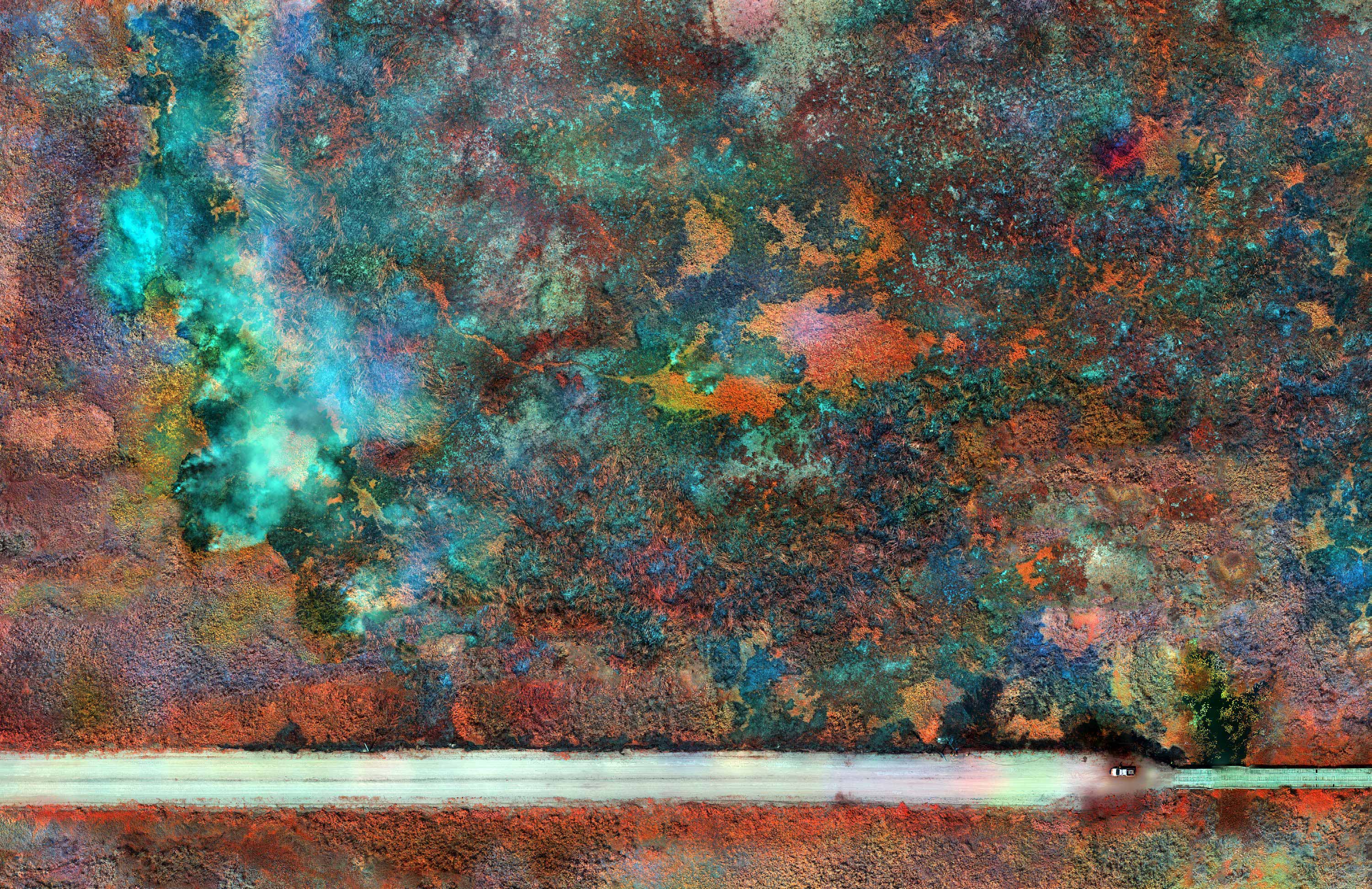
Courtesy of the artist and Jack Shainman Gallery, New York.
According to a 2021 UN report, 18 percent of the Amazon basin’s forested area has been converted to other land uses, with an additional 17 percent undergoing degradation. The panel identified overexploitation, deforestation and forest fragmentation as the main threats to biodiversity. On a more hopeful note, the report stresses the contribution of Indigenous territories and protected areas to safeguarding the rainforest basin (around 50 percent of the Amazon).
American Mine (Carlin Nevada 1), 2007
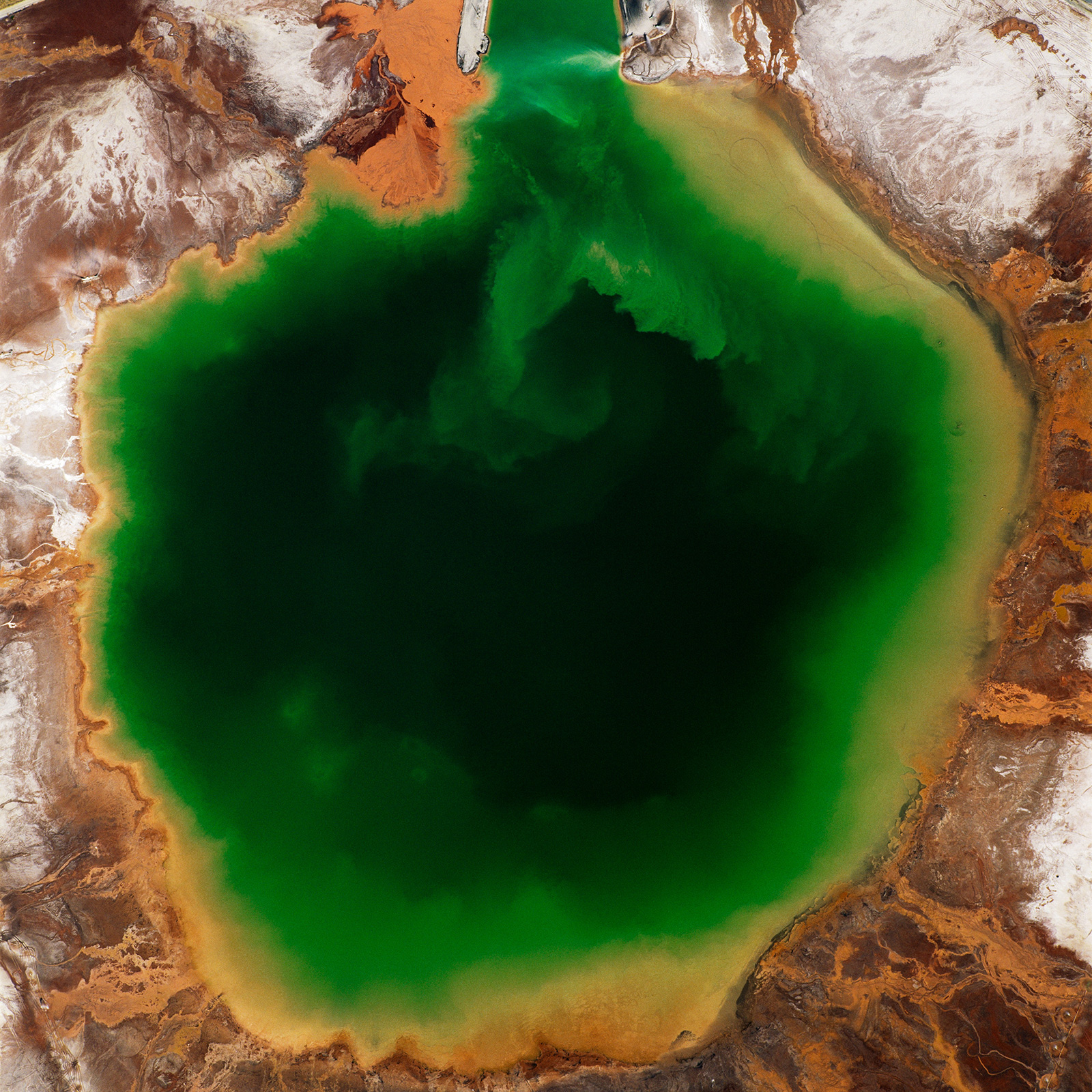
Archival pigment print, 48 x 48 inches
For over thirty years, American photographer David Maisel has produced aerial photographs of radically altered terrain in a multi-chaptered series titled Black Maps, revealing the physical impact of activities such as mining, logging, urban sprawl, and military testing. Rather than create literal documents, the artist has exploited the slippage between the evidentiary and aesthetic functions of photography to create images that encompass both stark documentary and tragic metaphor. In this moment of global reckoning with the environmental consequences of human activity, Maisel’s photographs are both prescient and timely.
Desolation Desert, Tailings Pond 1, 2018
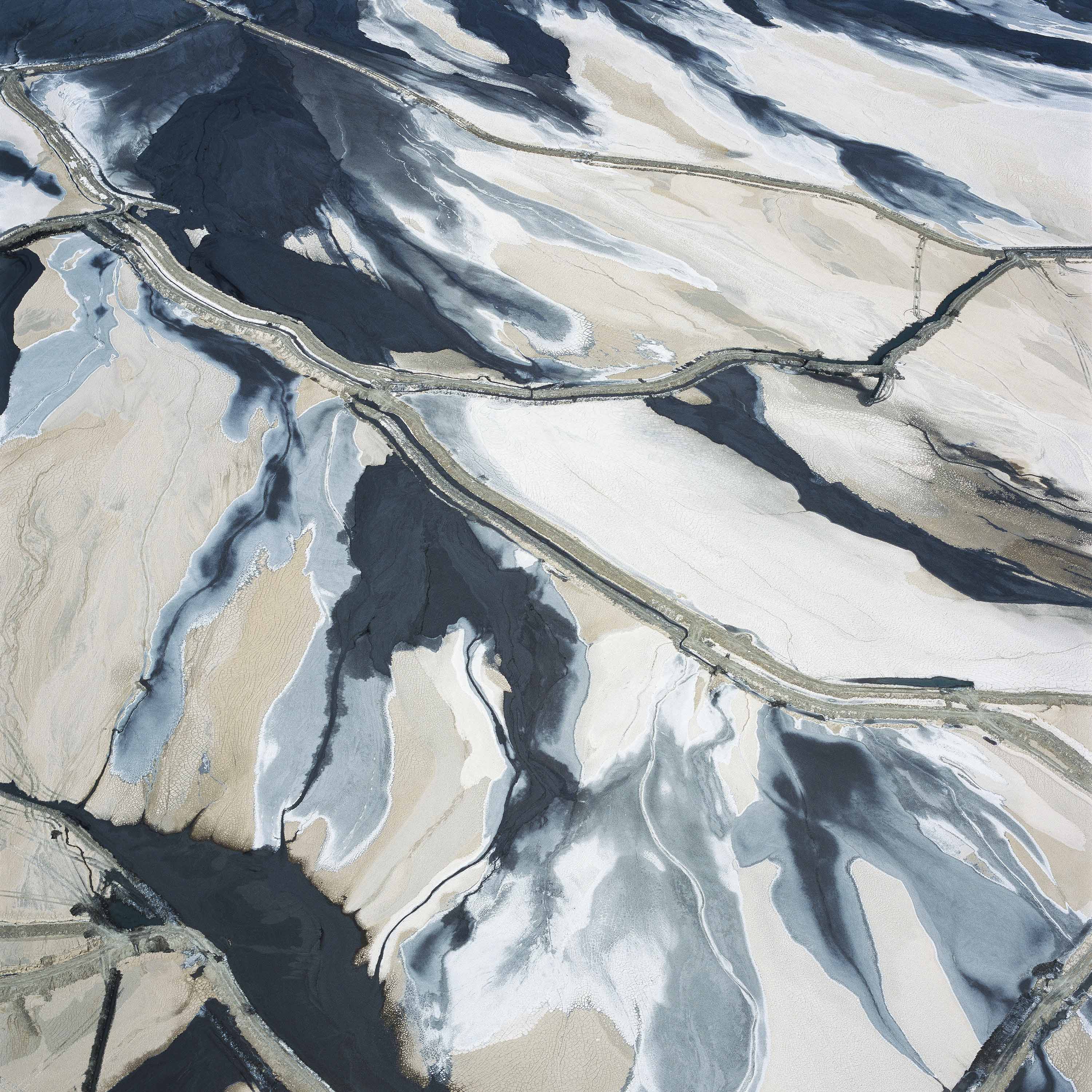
Minera Centinela Copper Mine, Antofagasta Region, Atacama Desert, Chile. Archival pigment print, 48 x 48 inches
Maisel is the recipient of a Guggenheim Fellowship in the Visual Arts and has served as Scholar in Residence at the Getty Research Institute and Artist in Residence at the Headlands Center for the Arts.
As citizens of an entrenched consumer society, we are collectively complicit in the creation of these depleted and damaged landscapes. - David Maisel
Harmony As A Hive (Performance Still)
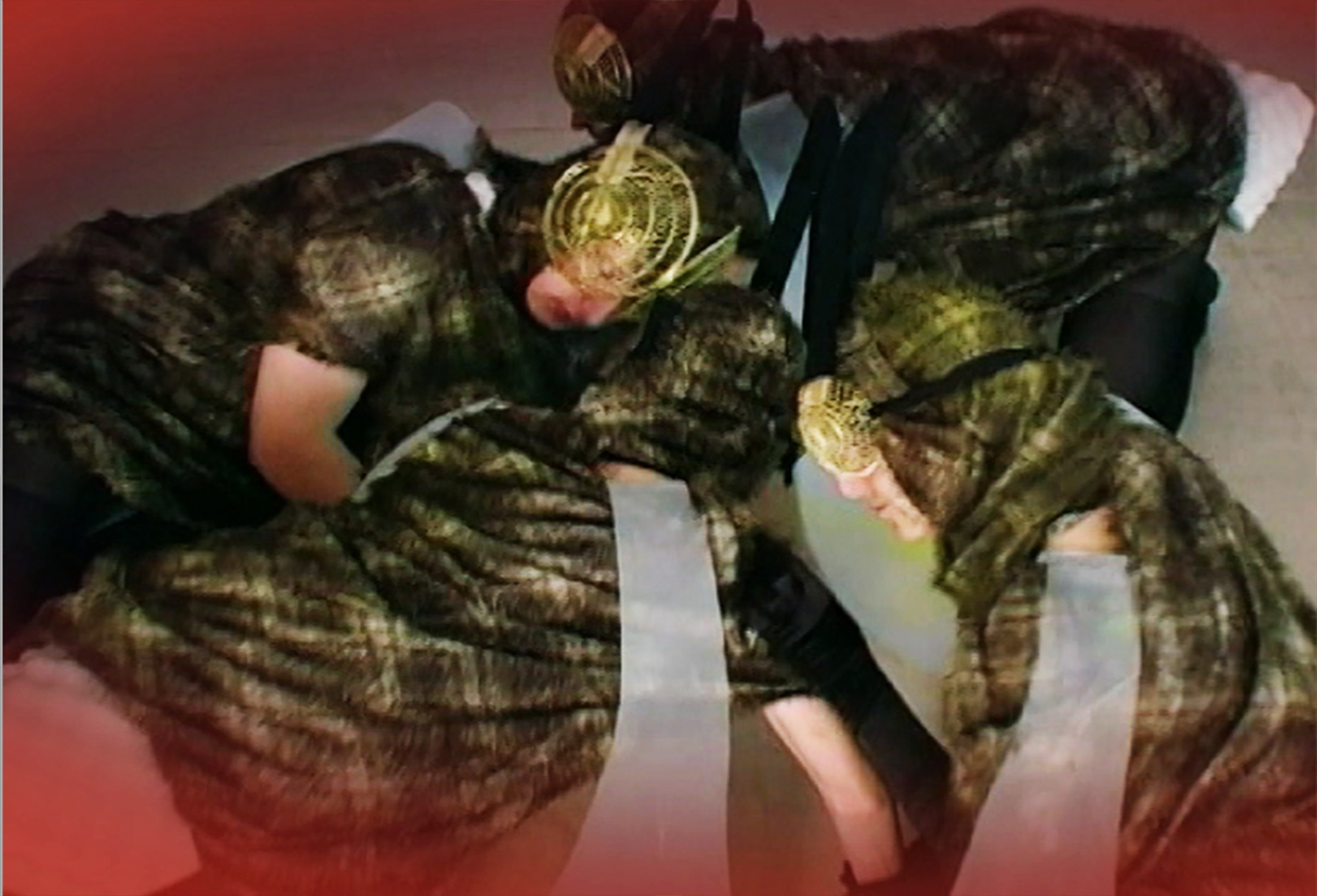
Archival print. 30 x 40 inches (2010)
In 2007, American artist Lenore Malen raised honeybees for two years. During the summers she spent countless hours sitting beside their hives and observing them. It made her think of our own hive mind, our own animality. Someone wrote that the hive is like an enormous animal whose arms span miles across and then retract. Similarly, our world consists of complex nets of relationships, cause and effect. Bees and ants live in societies nearly approaching utopia, but they are insects. Scientists now study gene selection in the hive to learn about the evolutionary roots of altruism and cooperation. It’s intriguing to think that the political project of utopianism— the human wish for perfect societies—could have its roots in evolutionary biology. Why do we get along at all and why not better? The fact that the honeybees have a perfect society, an idea espoused by Tom Seeley, (Professor of Neurobiology at Cornell U), goes against all thoughts of Western culture’s commitment to human exceptionalism.
Forces of Change, 2017
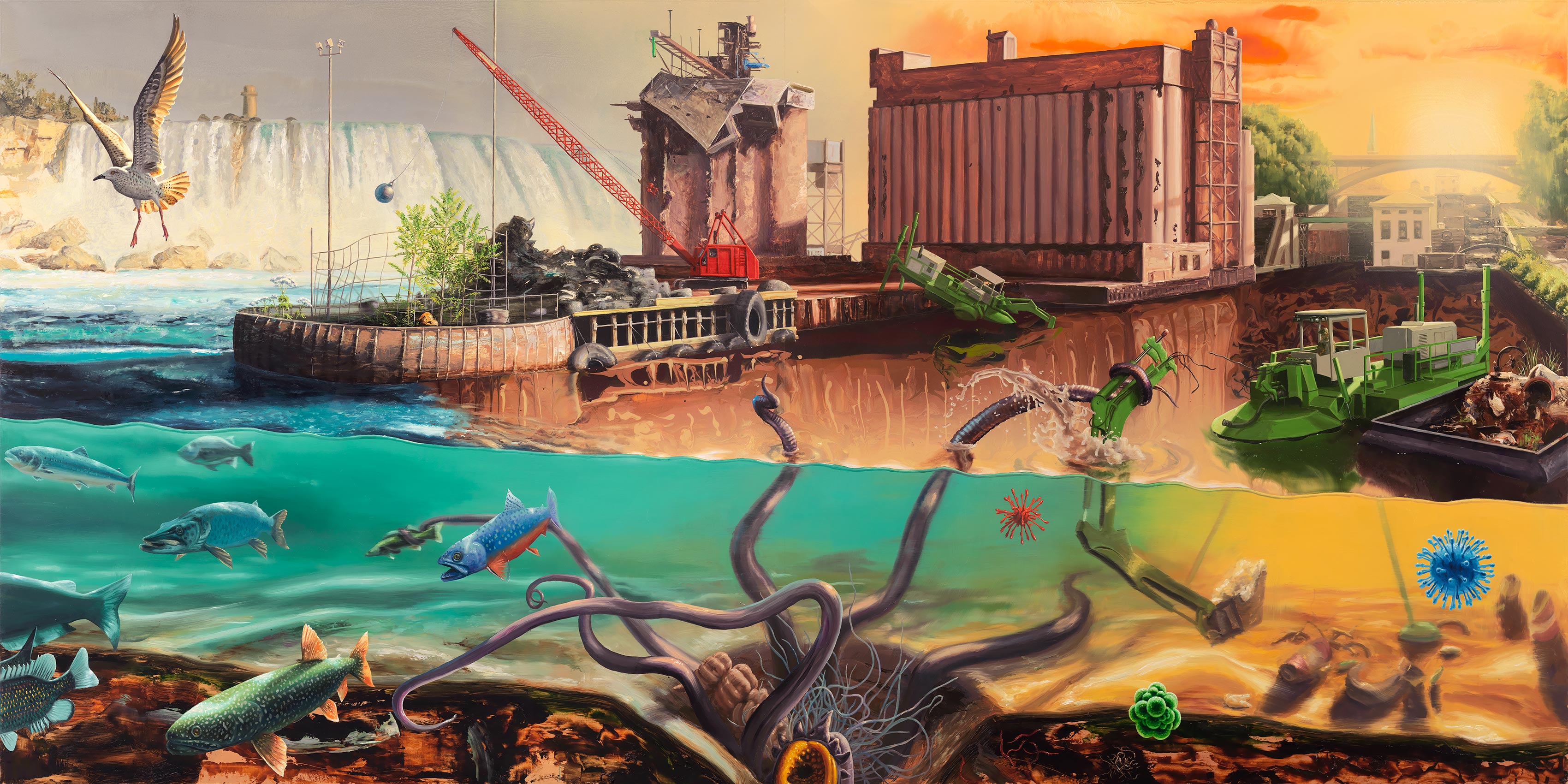
Oil and acrylic on wood panel. 72 x 144 inches
New York based painter Alexis Rockman is an eco-warrior who began making art in the service of environmental awareness long before it was fashionable, embarking on expeditions to far-flung locations like Antarctica and Madagascar in the company of professional naturalists. His work tells stories in which natural histories of the past confront dystopian futures.
His work has been exhibited around the world and showcased at prestigious galleries and museums including the the Venice Biennale, The Carnegie Museum of Art, Smithsonian American Art Museum, Serpentine Gallery and many more. Rockman also notably worked on Life of Pi with Ang Lee. Rockman’s art served as the backbone for much of the film’s aesthetics.
Bitter Water
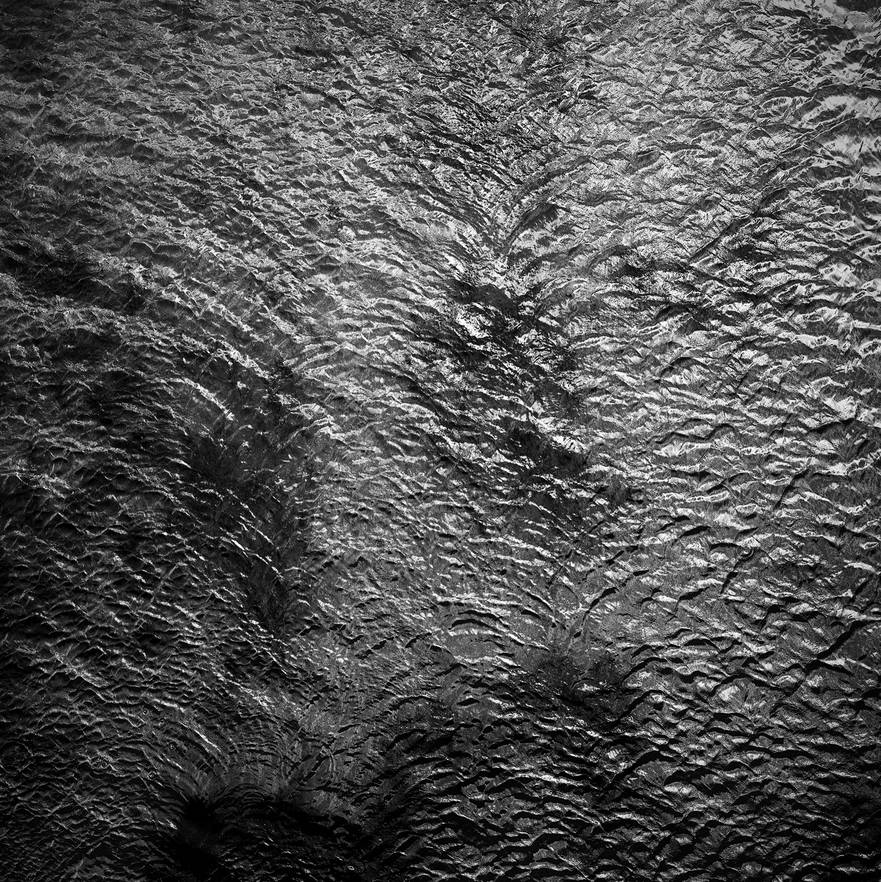
Archival pigment print (dibond). 70 x 70 cm. Edition of 3 with 2 AP (Limpopo, border between South Africa and Zimbabwe, 2017)
Garth Meyer (born 1967, South Africa) is a photographer and filmmaker. He is part of The African Film Library and is interested in the many creative uses of cinematic form, style, and genre, set against the backdrop of South Africa’s complex and often turbulent social and political landscape. His current thematic exploration and investigation considers transgression, borderlands and political ecologies.
Photographing the Limpopo from Beit Bridge made me consider the colonial control of ideological space, which has had such a direct influence on how people have been classified and imagined. Bitter Water is a series of photographs of seven South African rivers, as boundaries or borders, photographed over a period of two months in varying weather patterns. The abstraction of water, without any land features or visible marks, is an allegory of a border of historical and ideological imagination. Rivers became easy markers of imagined land division during colonial occupation. The seven rivers stand as boundary symbols and borders of the actualization of imagined and ideological space. - Garth Meyer
Gratitude Code Root Mural
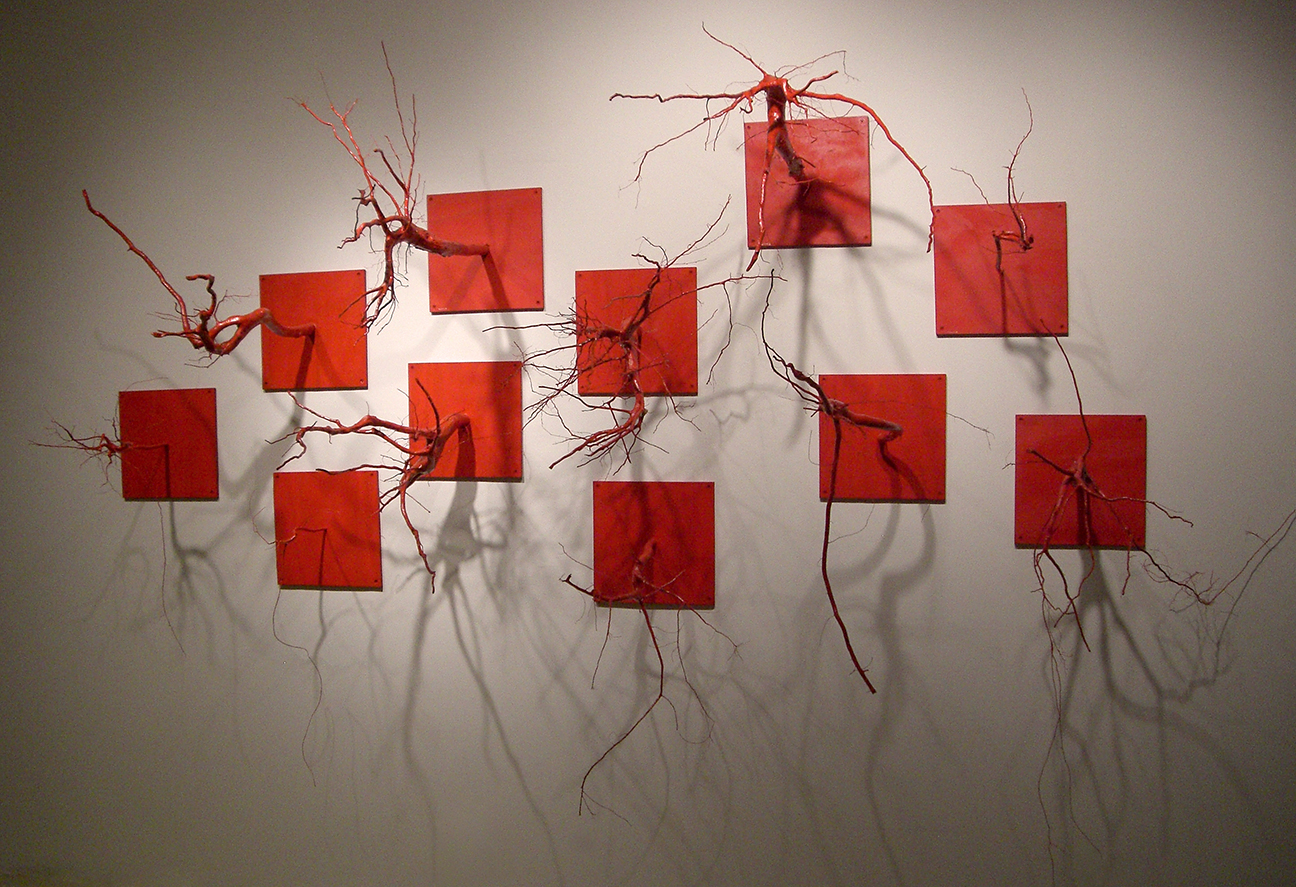
Felt tip marker and acrylic on sapling roots and plywood, approx. 114 x 48 inches (2009)
A Plains Cree/Anishnawbe/Metis artist educated in both Indigenous and Western creative traditions and genres, Bebonkwe/Jude Norris creates from the foundation of ancient yet ever evolving First Nations culture, while pushing the boundaries of Western postmodern arts practices. She juxtaposes elements of Native material, language, creative practice, technologies and iconography with often disparate Western ones, creating dynamic and signature combinations of the traditional with the technical and the organic with the digital in contemporary artworks that embody Aboriginal embrace of storytelling and love of the land. Working from the Indigenous approach of centering relationship, Bebonkwe employs an empathic and prayerful approach to her variety of media. Her artworks often incorporate cultural gathering practices and collaborations with plant and animal relations, and continue the fem-centric abstraction practices of Plain Nations in innovative ways.
Gratitude Root Mural, part of the ‘natura directus et delectabilis’ series, features 11 sapling roots, painstakingly and lovingly gathered, peeled, painted and then covered with the word gratitude, handwritten in three languages; Plains Cree syllabics, English and binary code, over the entire surface of the roots.
Ogony Boy
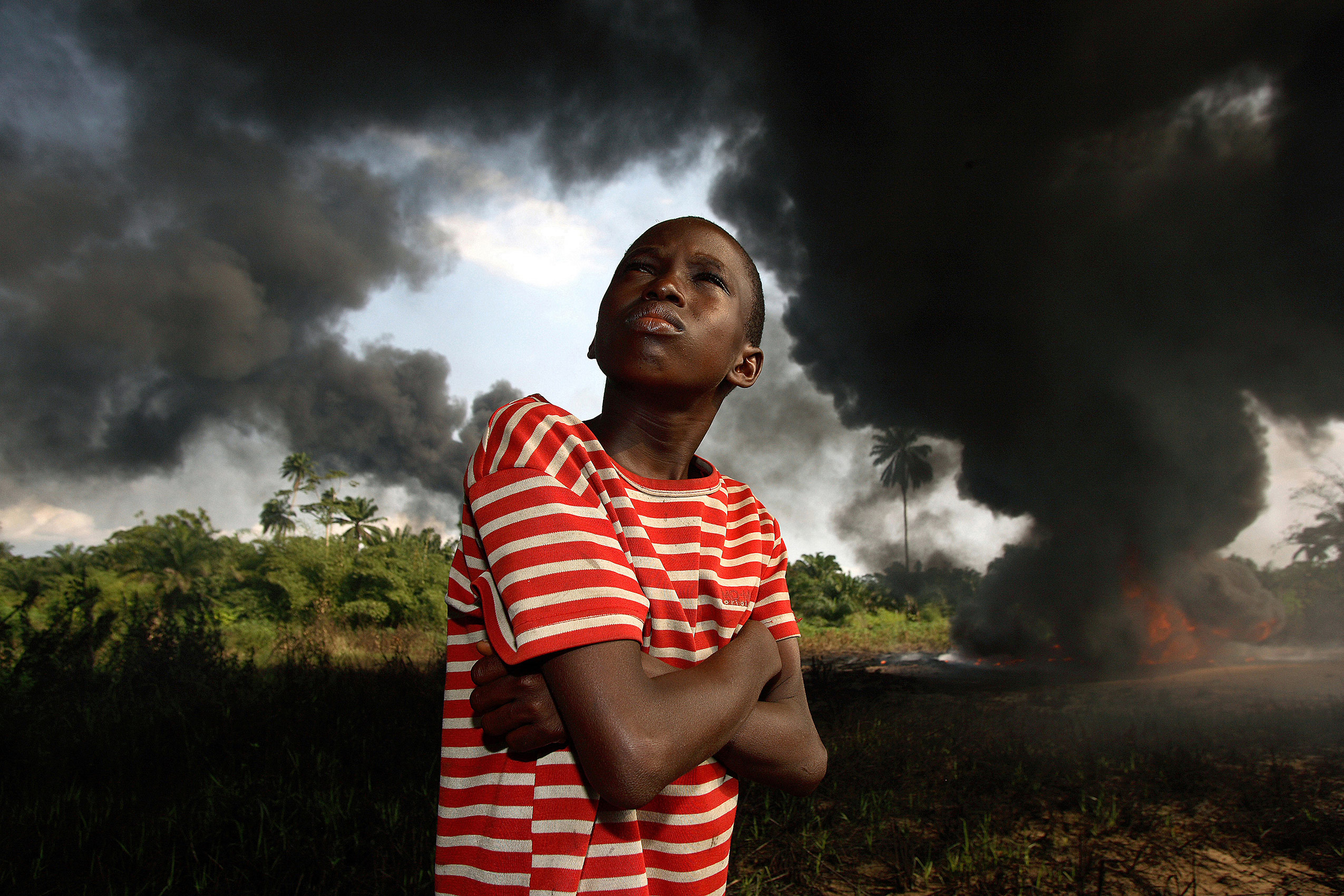
From the Oil Rich Niger Delta series. C-print (2007)
Nigerian photographer George Osodi is a strong believer in the camera’s ability to incite change. This belief led to his career as a photojournalist, which greatly influenced his work as an artist. His Oil Rich Niger Delta (2003–2007) series is one of his most well-known projects and put him on the map of the contemporary African art world. The series, comprising two hundred images, is an artistic photographic reportage of the environmental, economic, and social impacts of oil in the Niger Delta region.
I want to put a human face on this paradise lost, in order to provoke a feeling and trigger a deep sense of change within the observer.
- George Osodi
The Freshmaker
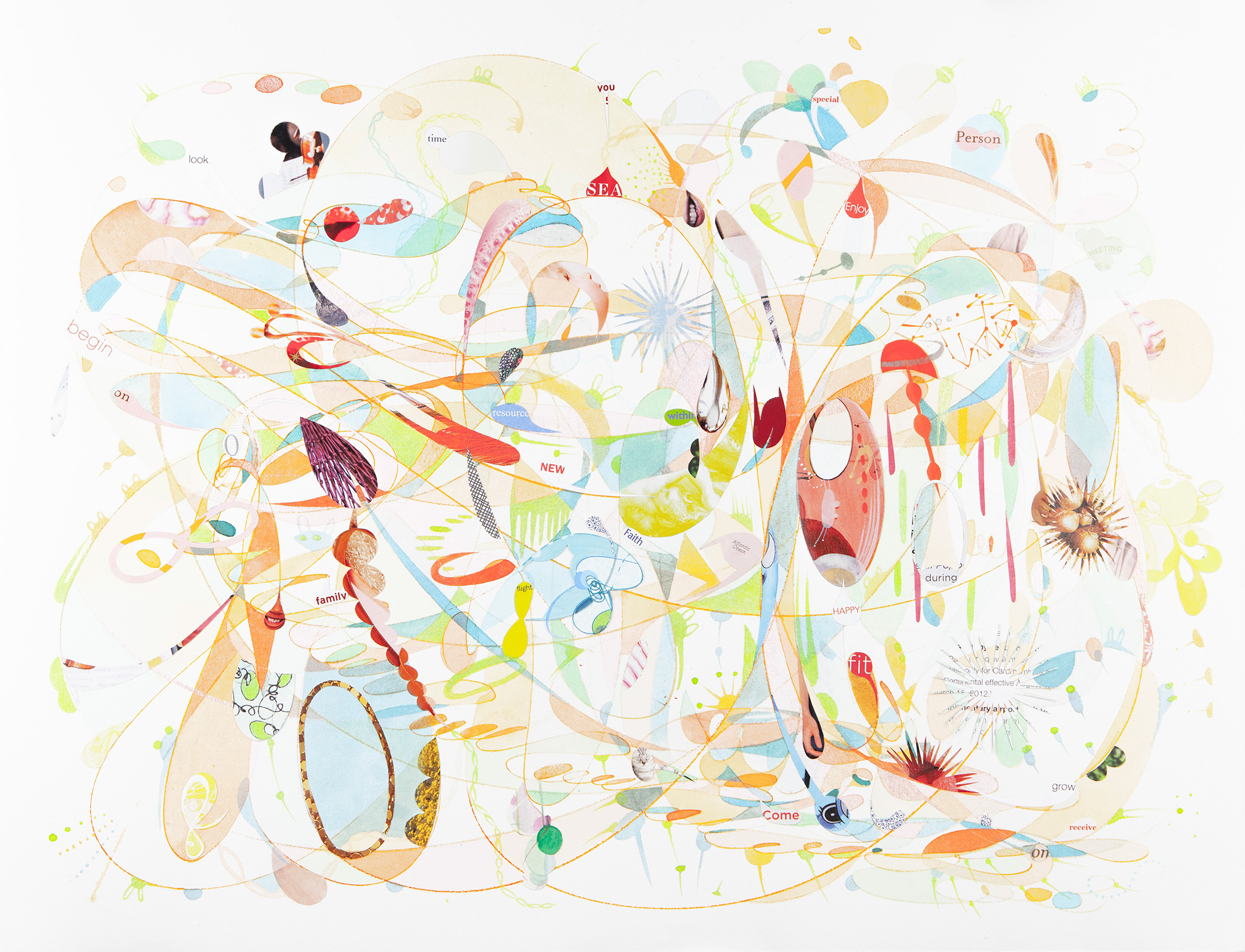
Ink and junk mail on paper. 15 x 19 inches (2017)
Aurora Robson is a Canadian/American multi-media artist known predominantly for her meditative work intercepting the plastic waste stream. Her practice is about subjugating negativity and shifting trajectories.
Kamilo was made with plastic debris cleaned up from Kamilo Point by the Hawaii Wildlife Fund, which has been conducting clean ups there for over a decade. Robson created the piece with assistance from students at The Parker School in Waimea. Robson is also the founding artist of Project Vortex, an international collective of artists, designers and architects who work in innovative ways with plastic debris. Robson is passionate about developing integrative methods for artists and designers to utilize plastic debris as a raw material.
Kamilo
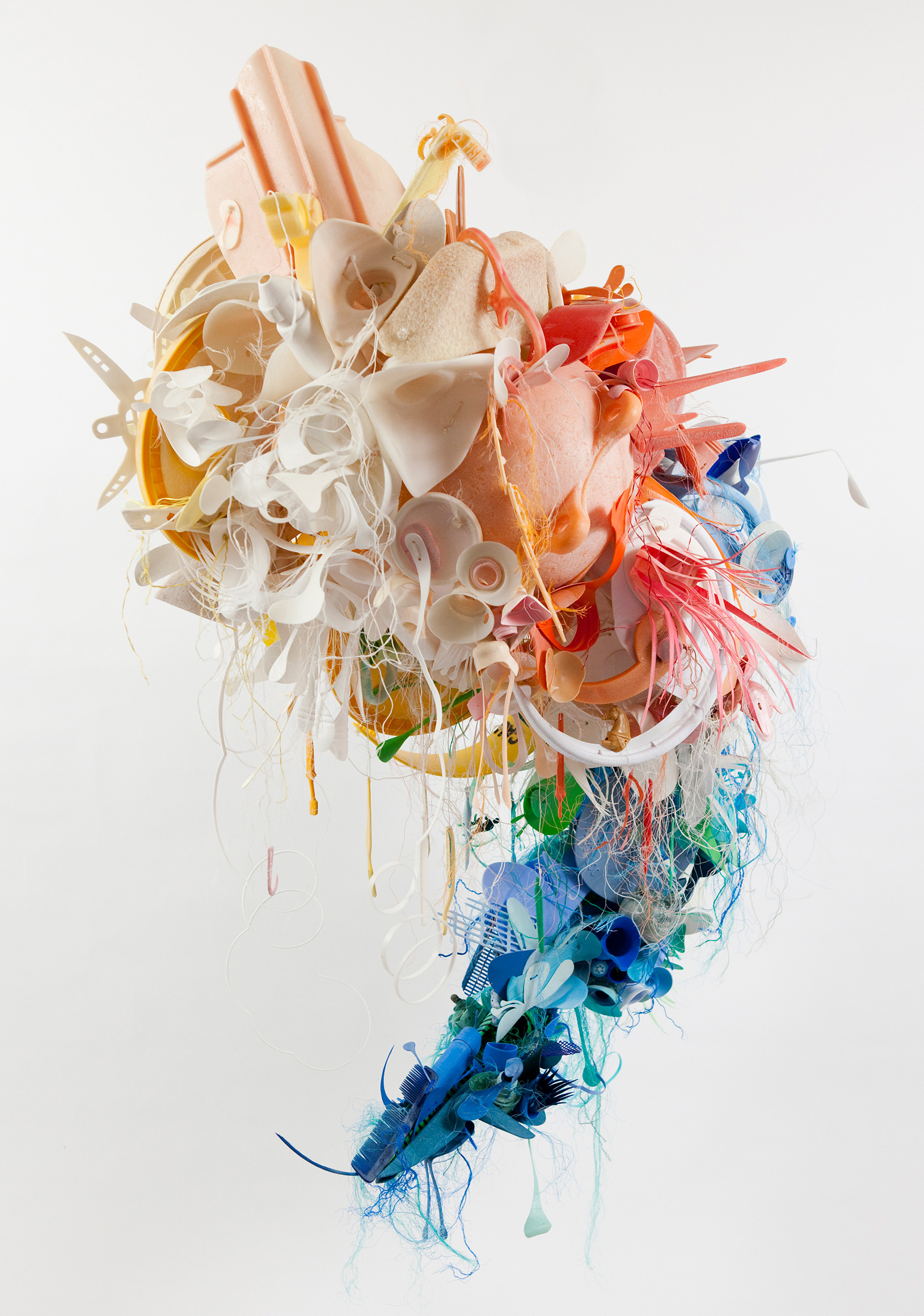
100% ocean plastic debris. 60 x 48 x 36 inches (2011)
S.O.S. Pledge

Tattfoo Tan is a New York based artist who collaborates with the public on issues relating to ecology, sustainability and healthy living. His work is project-based, ephemeral and educational in nature.
S.O.S. Pledge is a unique artwork that is based in a concept, a mission, a promise that carries its message and virtue formless across all mediums and platforms that suit the budget, aesthetic, size and location of its custodian, which can be proudly displayed in a public area. It had been reborn as a marble mural in a school, a plywood board in a community garden, a handkerchief for portability and even as a temporary tattoo.
Aquatic Larvae
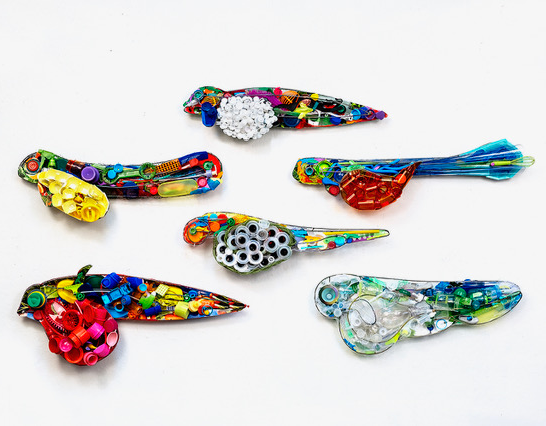
Welded steel and single use plastic debris, each approximately 33 X 13 X 8 inches (2020)
Christy Rupp is an American artist and activist. She lives and works in New York City and the Hudson Valley in New York. Animal behavior inspires her work. She is one of a group of early eco-artists concerned with urban ecology and human's perceptions of nature. This installation of eight enlarged aquatic larvae made from single use plastics represents the omnipresence of micro plastic particles now evident in all stages of organic life.
The Bukhara Deer
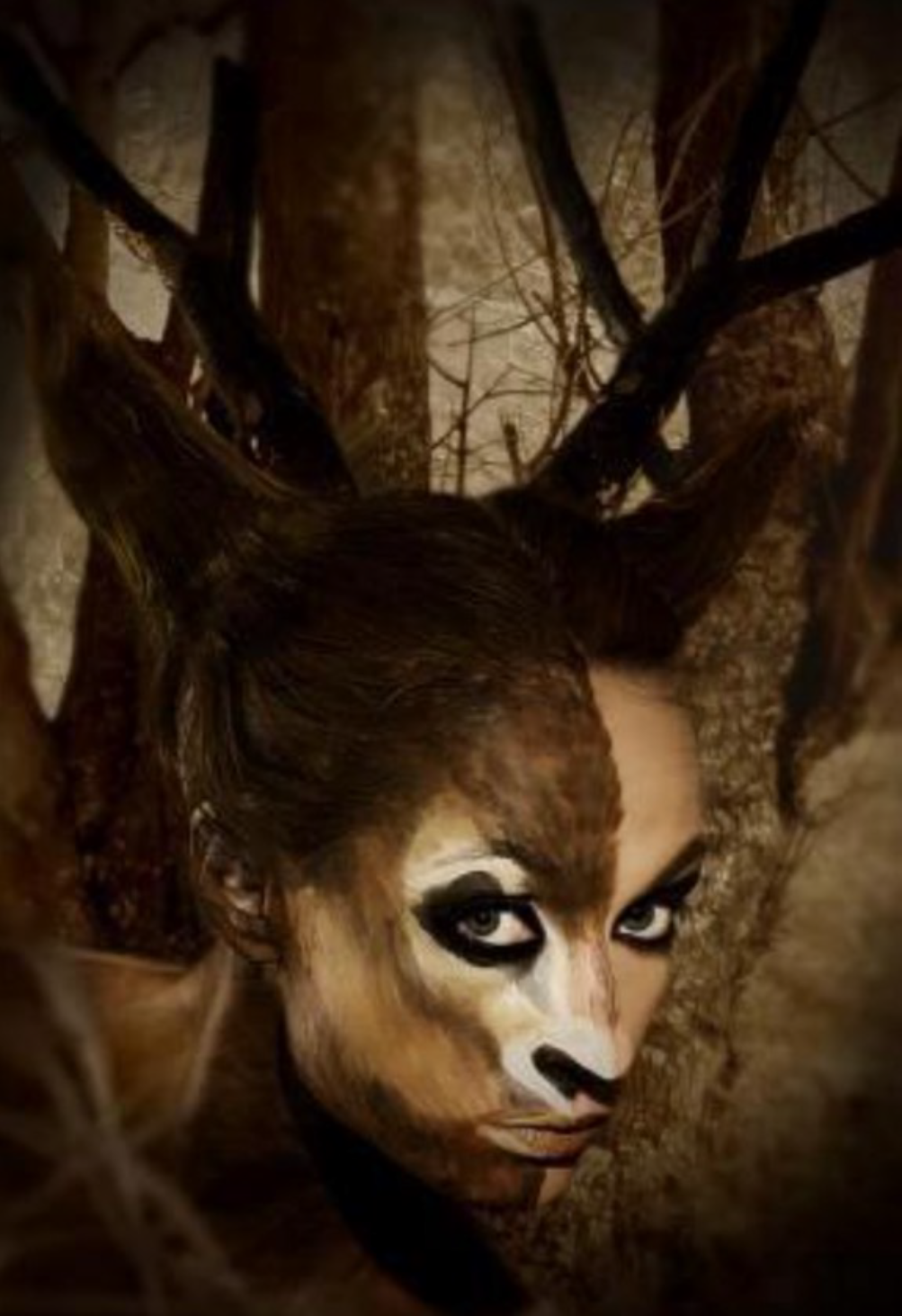
Archival pigment print. 27 x 40 inches (2011)
The UNDP Global Environment Facility (GEF) Small Grants Program in Uzbekistan (represented by project coordinator Alexei Volkov, Studio "Kanaki" and art painter Ekaterina Kovshova) collaborated on an art project in efforts to protect the wildlife of Uzbekistan. Local celebrities transformed into animals to create an impact with messaging about biodiversity and the interconnectedness of nature. Each model was disguised through art paintings into local animals in danger of extinction.
The Bukhara deer, with only a few hundred individuals left, faces the threat of extinction as a result of human activities, such as political conflicts, artificial regulation of the water regime, habitat destruction and illegal hunting.
Power of Tajá
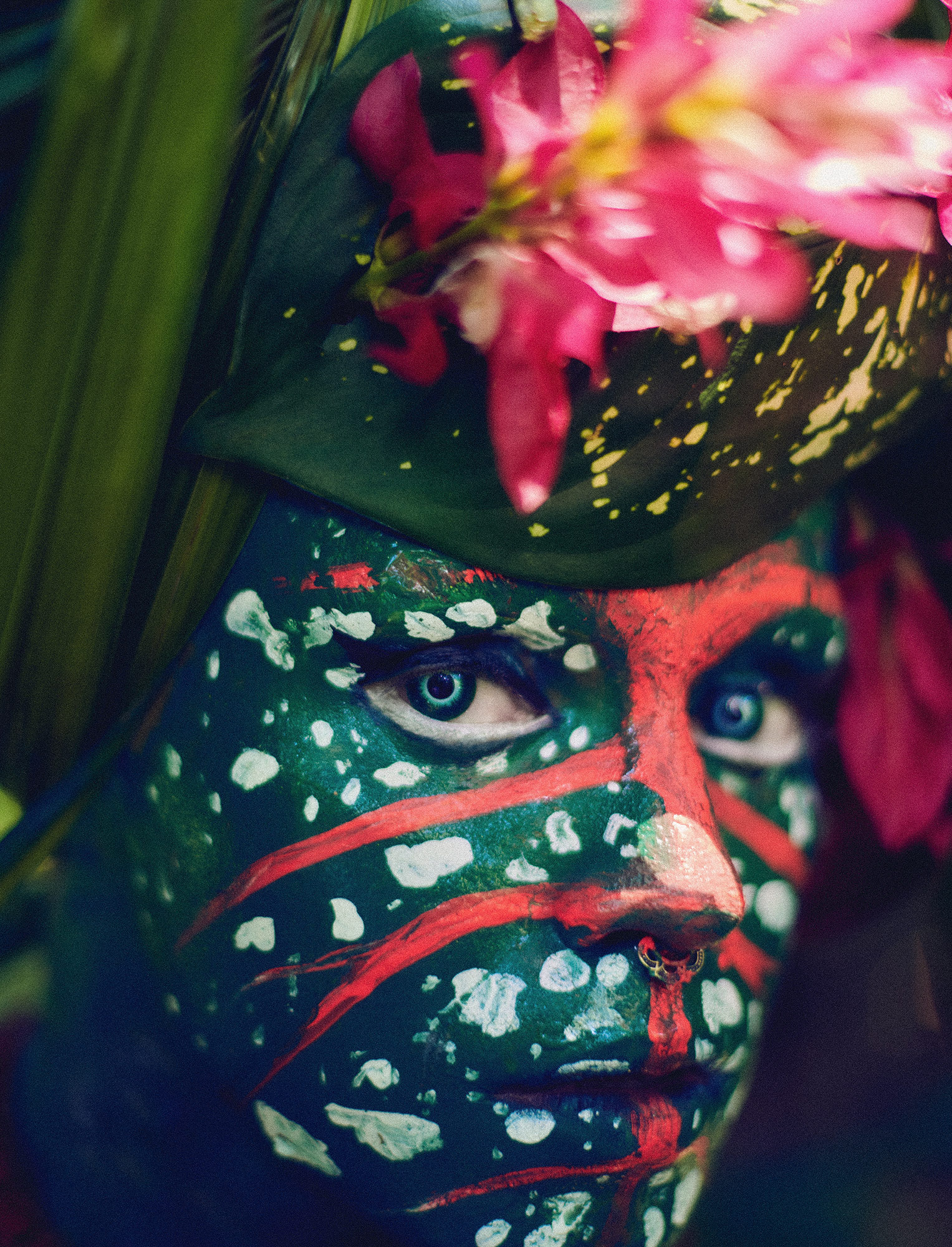
Print on fine art paper. 51 1/5 × 39 2/5 × 1 1/5 inches. Editions 1, 2, 3, 4, 5 of 5 + 2AP (2020)
Emerson Uýra is a young artist, scientist, and educator of Indigenous ancestry from Mojuí dos Campos, Santarém in the Amazon. Through his drag persona, Uýra Sodoma, Emerson Uýra blurs the lines between human, animal, and plant. Out in the streets of the Amazonian city of Manaus, Brazil, or in the sterile space of the art gallery, Uýra mesmerizes audiences with his disrupting of colonial narratives of wilderness, gender, and environmental destruction.
A visual artist and human rights activist, Uýra is also a biologist with a masters degree in ecology. Whether he is inhabiting Emerson or Uýra Sodoma, he is pushing for diversity, rights, and racial justice.
41.3504 N, 72.4052 W
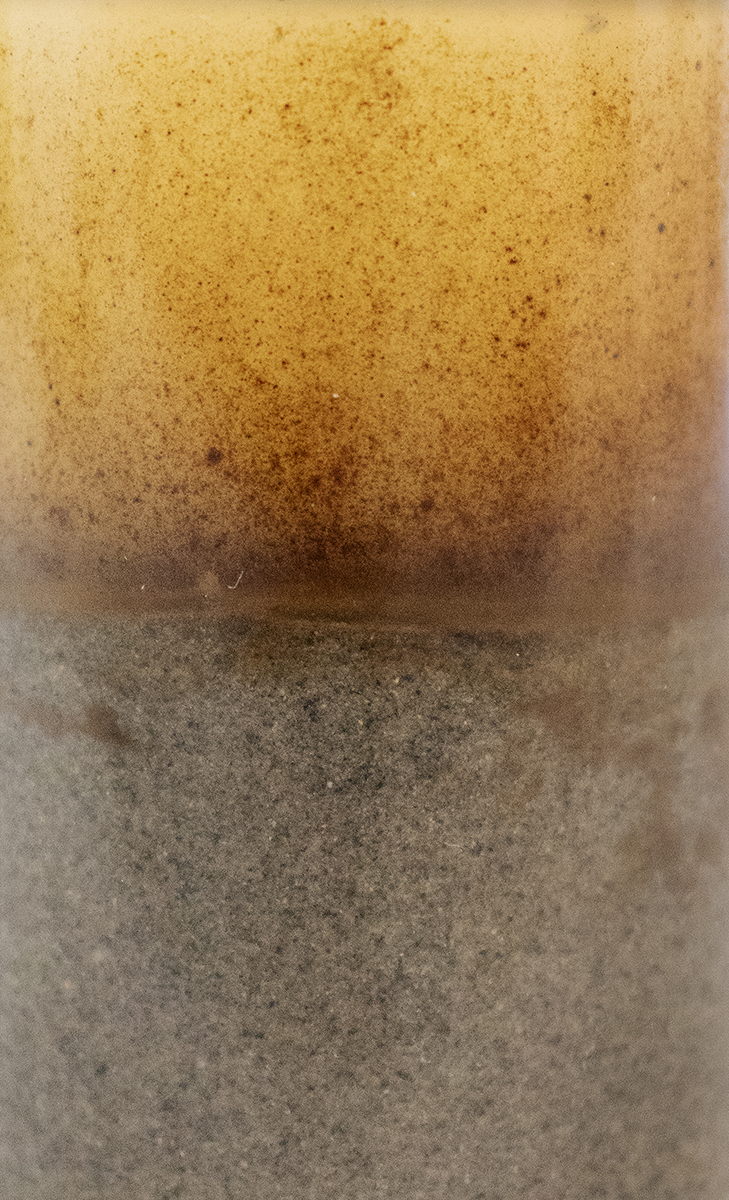
Digital print on painted mylar. 25 x 17 inches framed (Essex, CT, 2019)
Marion Wilson's art investigates ecology and landscape to foster a closer connection to self and place. Marion Wilson examined bodies of water in New York, Connecticut, New Hampshire, and Maine in the photographic series The Waters of My Childhood, which documents bodies of water that the artist visited regularly as a child. Northeastern regions share similar histories and ecologies where water played an essential role in the growth of factories and neighboring cities during the Industrial Revolution. Today, these areas are also among the fastest-warming states in the nation and several of these bodies of water are no longer safe for swimming.
40.9503 N, 72.4052 W
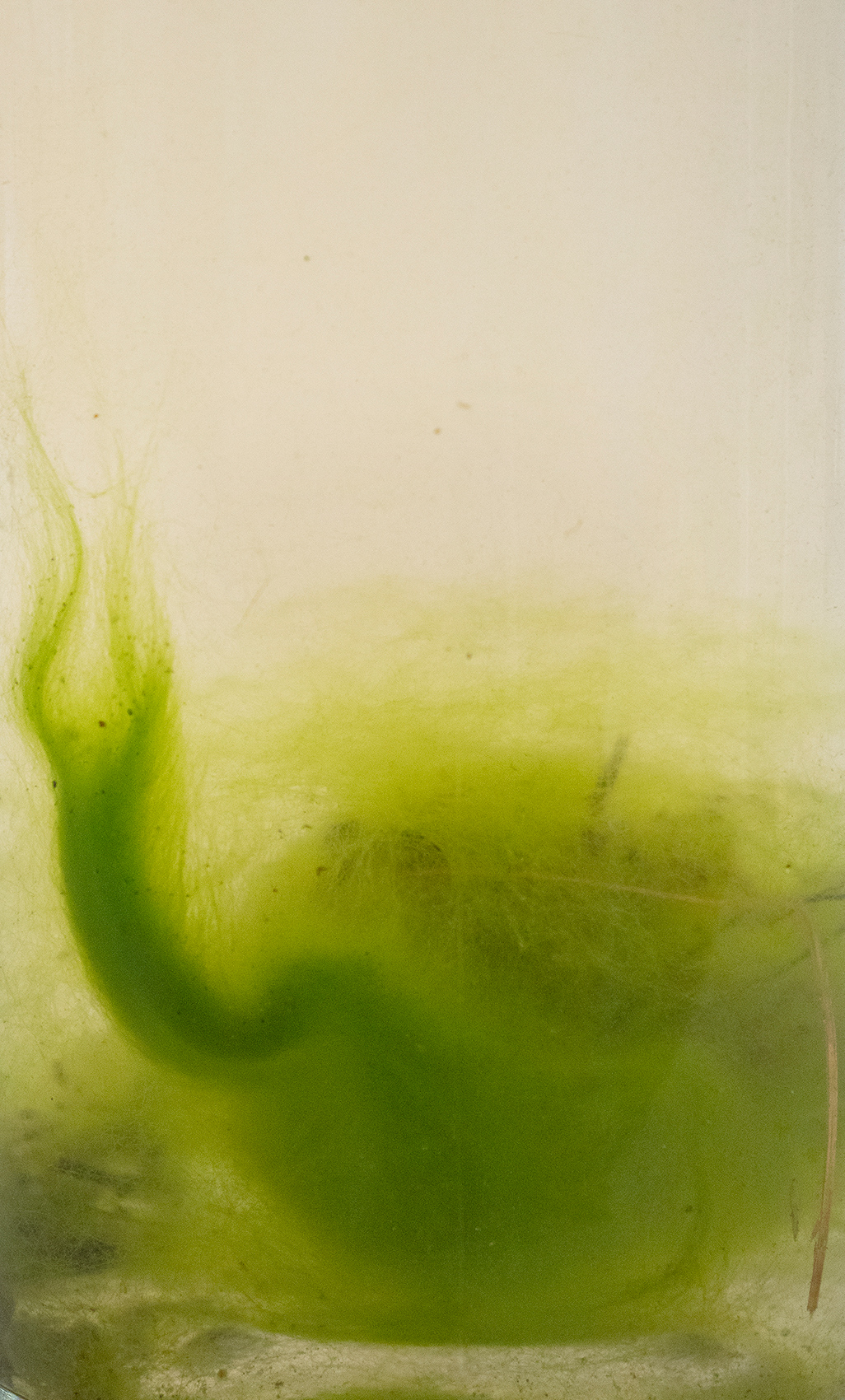
25 x 17 inches framed (Lake Hopatcong, NJ, 2019)
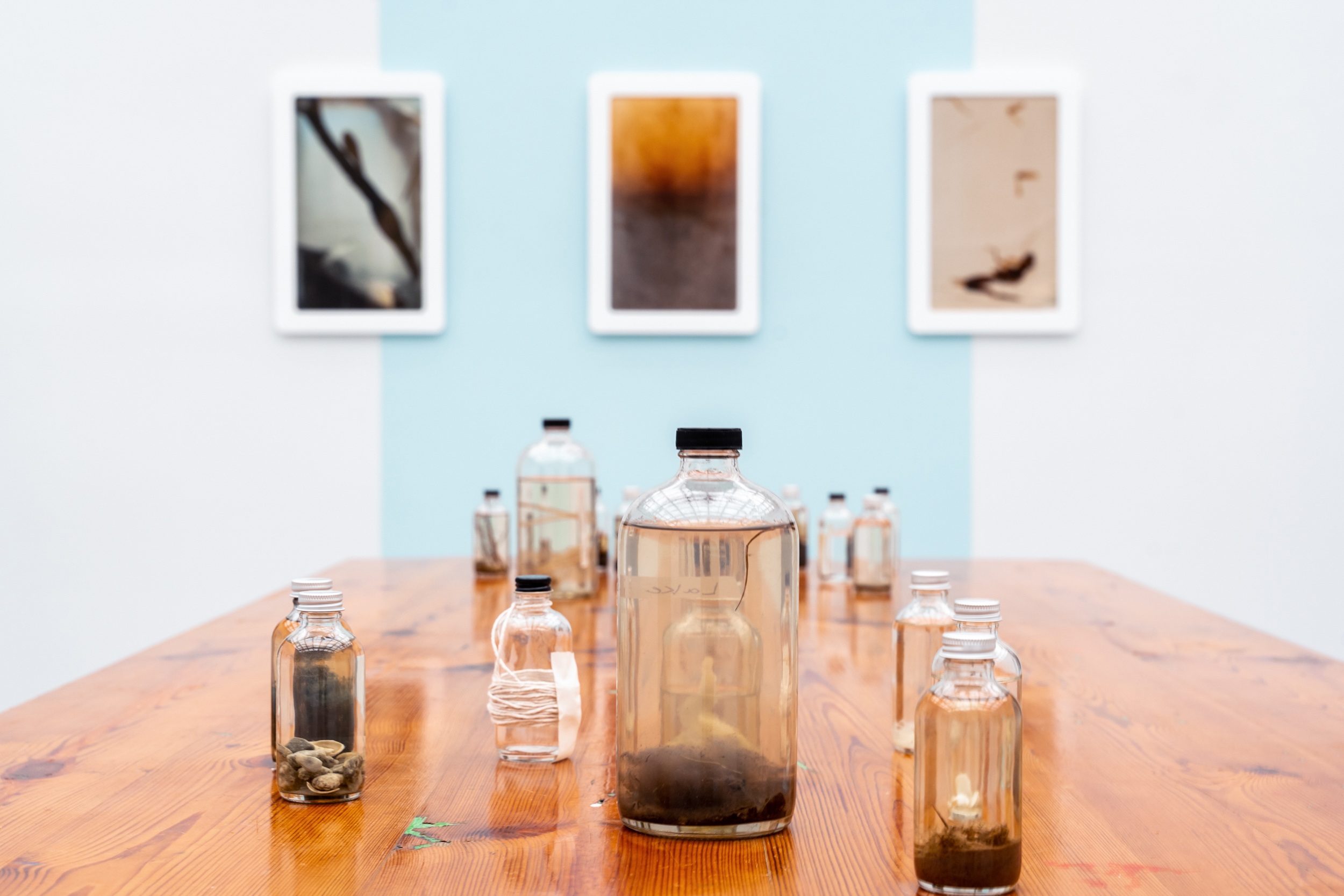
Oyster Reef
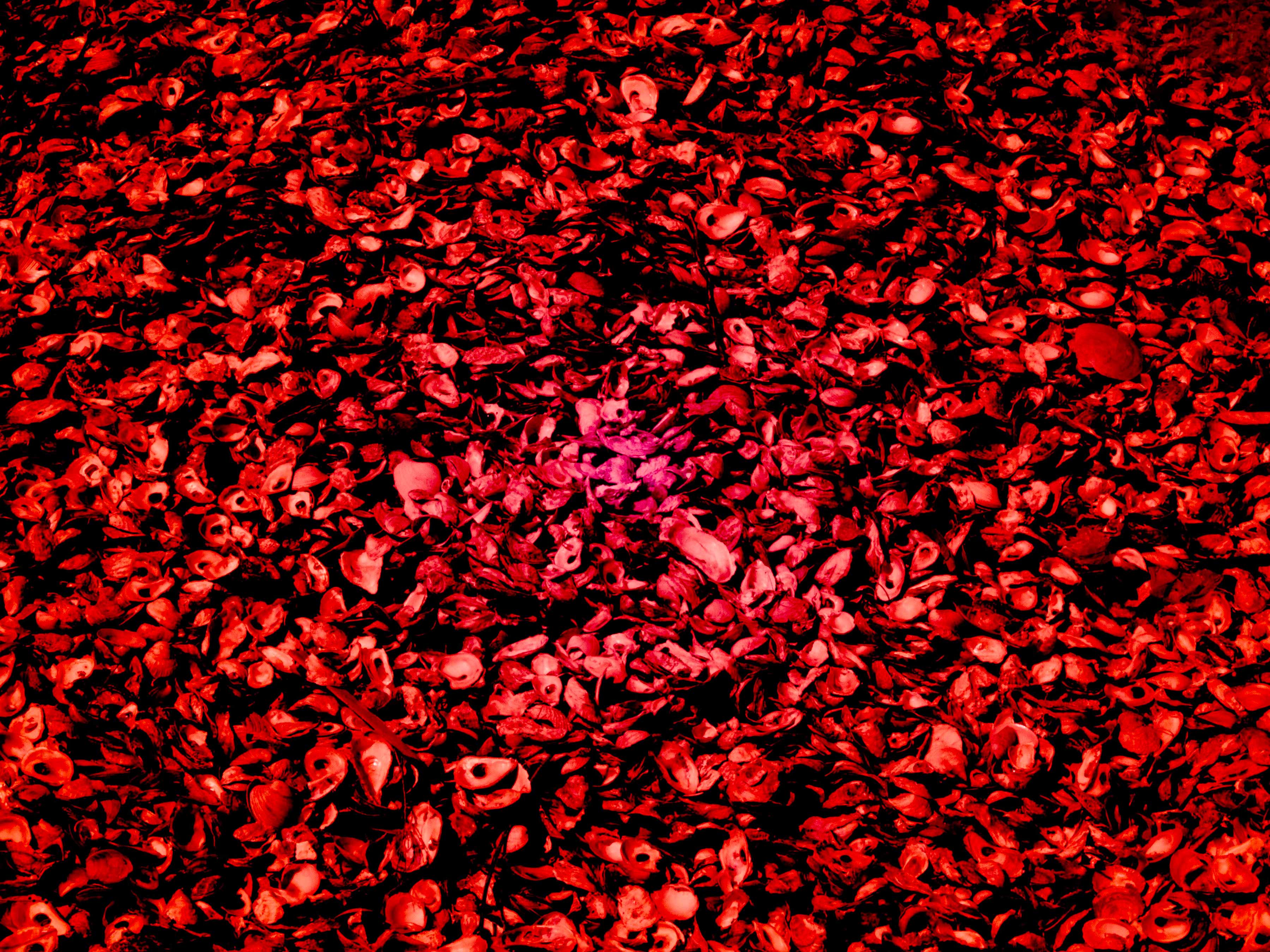
Infrared chromogenic print, 30 x 40 inches mounted on plexiglass (2022)
Laziza Rakhimova is an environmental artist (born, Tashkent, Uzbekistan). Her work blends art and environmental activism. She recently worked on Gowanus canal water contamination and NYC parks projects.
As part of the LMCC residency in the Art Center on Governors Island, Laziza works with oysters and marine habitats. She creates camera-less photography installations, and by using infrared light, she captures the island’s landscape. The series "Resilient Wall" alludes to the fragility of the natural habitat, its enduring resilience and the urgency of restoration. Artificial oyster reefs created by the Billion Oyster Project* span along NYC waterfronts, in hopes to re-wild and protect the city from flood surges. Resilient Wall is a metaphor for waves attenuation, waterfront reinforcement, erosion reduction and creation of home for marine diversity. It represents a beacon of hope that one day New York harbor will regain its natural protection.
*Billion Oyster Project aims to restore one billion live oysters to New York harbor by 2035, using discarded shells that provide homes for larvae that are placed in artificial reef structures in the harbor.
"The ecological crisis we face is so obvious that it becomes easy...to join the dots and see that everything is interconnected. This is the ecological thought. And the more we consider it, the more our world opens up. "The ecological thought"...is a vast, sprawling mesh of interconnection without a definite center or edge. It is radical intimacy, coexistence with other beings, sentient and otherwise." (Morton, 2012, The Ecological Thought).
According to many scientists, starting in the mid-20th century we transitioned from the geological epoch Halocene to the period Anthropocene, in which human species are driving planetary degradation. Future generations will have to grapple with the changes of the warming planet. The Anthropocene is a moment of awareness of the triple planetary crisis (a climate crisis, a nature crisis and a pollution crisis).
The exhibition is curated by Laziza Rakhimova in consultation with Patricia Lea Watts, founder of ecoartspace. It is presented by UNDP GEF Uzbekistan and UNEP.
Acknowledgments: NYC Culture Club, Alexey Volkov, Bebonkwe/Jude Norris, Tanya Harnett, Chris Costan, Marianna Olinger, and Satwant Kawur.
This exhibit was launched in April 2022

